Many people are beginning to question whether a college degree (which usually comes along with debt) is worth pursuing. And while the answer to that is complicated, we can still be sure that you should at least get a high school diploma.
People who finish high school make a median salary of $42,835 annually. In comparison, non-high school graduates earn $29,800. However, the value of a diploma varies significantly by state, according to a report by the U.S. Career Institute.
Here is how much a high school diploma is worth in every state and the District of Columbia, ranked from least to most valuable.
51. Iowa
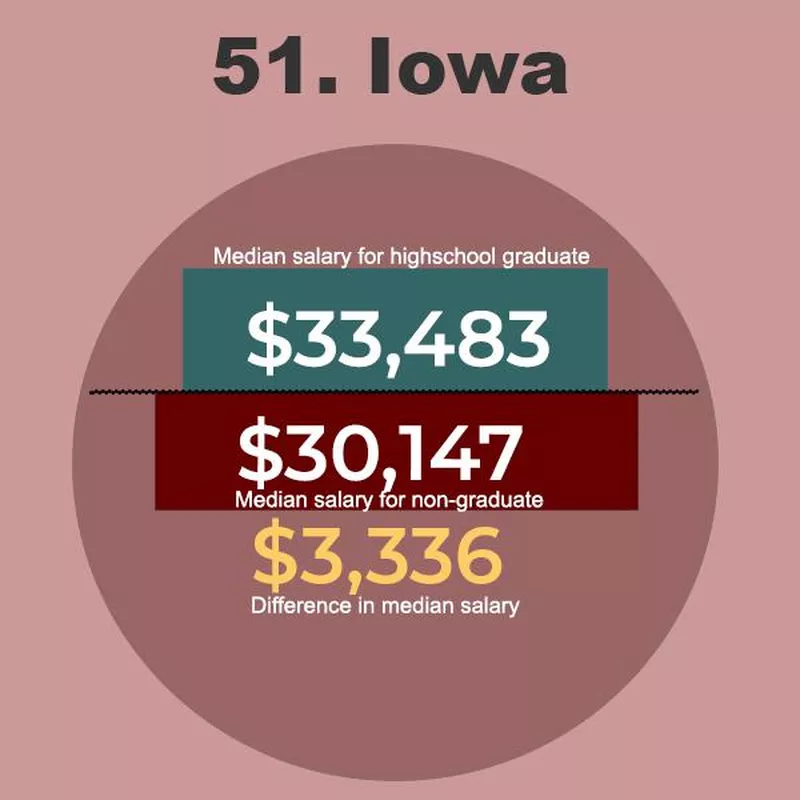
Heather Comparetto / Far & Wide
Iowa ties for the highest high school graduation rates in the country, with 94 percent of people receiving their diplomas. And yet, the U.S. Career Institute report shows that the state also has the lowest difference between salaries for graduates and non-graduates. The former group makes only about $3,336 more than the latter.
Interestingly, non-graduates in Iowa enjoy the third-highest salary out of any state, earning about $30,147.
50. Nebraska
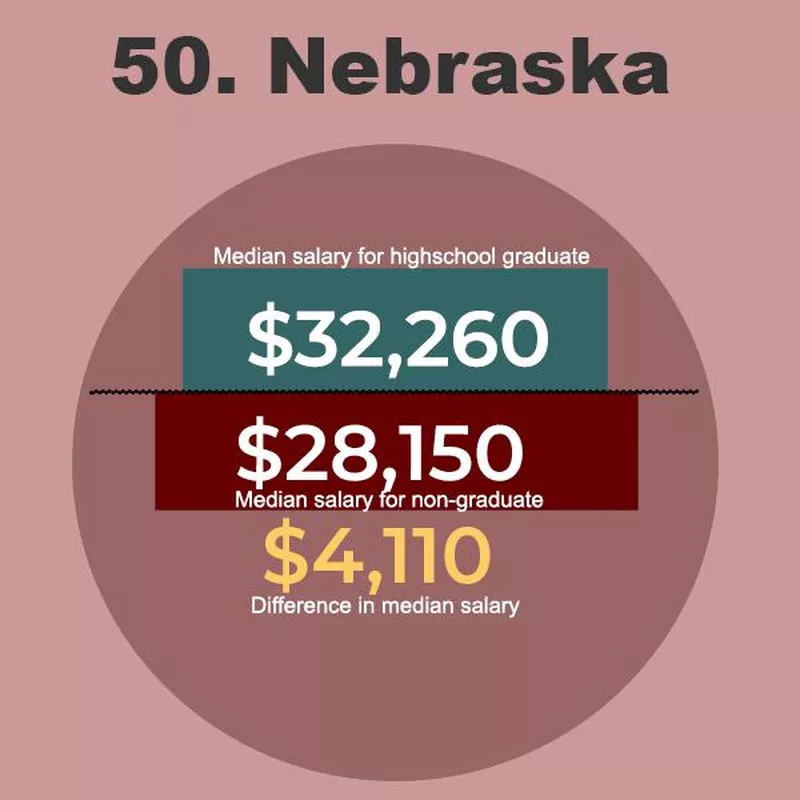
Like neighboring Iowa, Nebraska has a high graduation rate for secondary school, about 92 percent.
Manufacturing and farming are two of Nebraska’s largest industries. You can usually find a job pertaining to either without a diploma, which explains why people who don’t graduate don’t face drastic salary loses.
49. Idaho
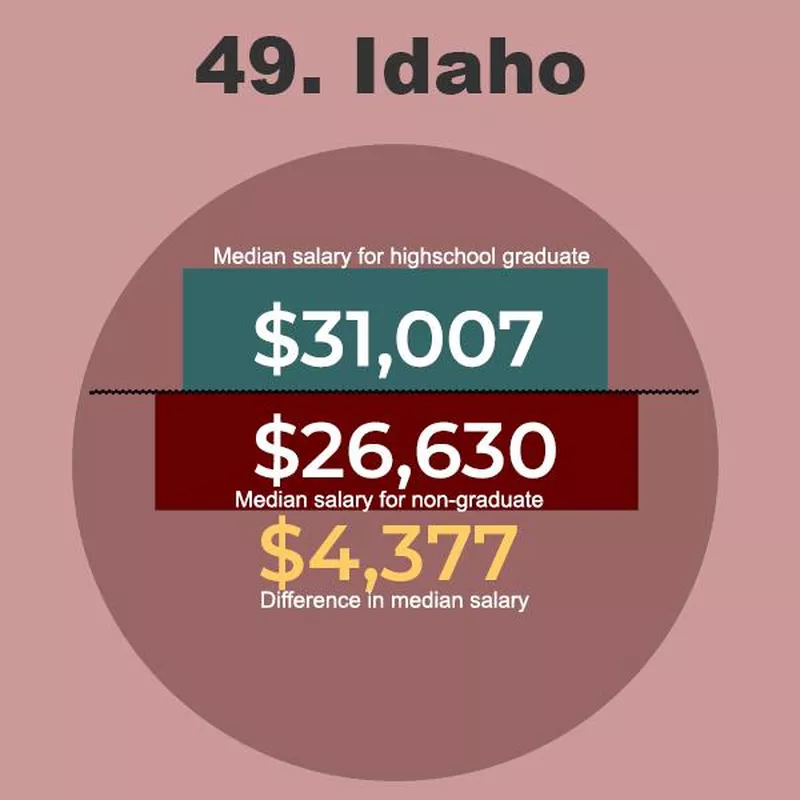
Breaking the pattern, Idaho has a relatively low high school graduation rate (87 percent). While the state also relies on agriculture, its most significant industries are real estate, manufacturing and retail trade. New car dealers make more money than any other type of business.
Again, these are all areas in which people can work without a diploma.
48. Nevada
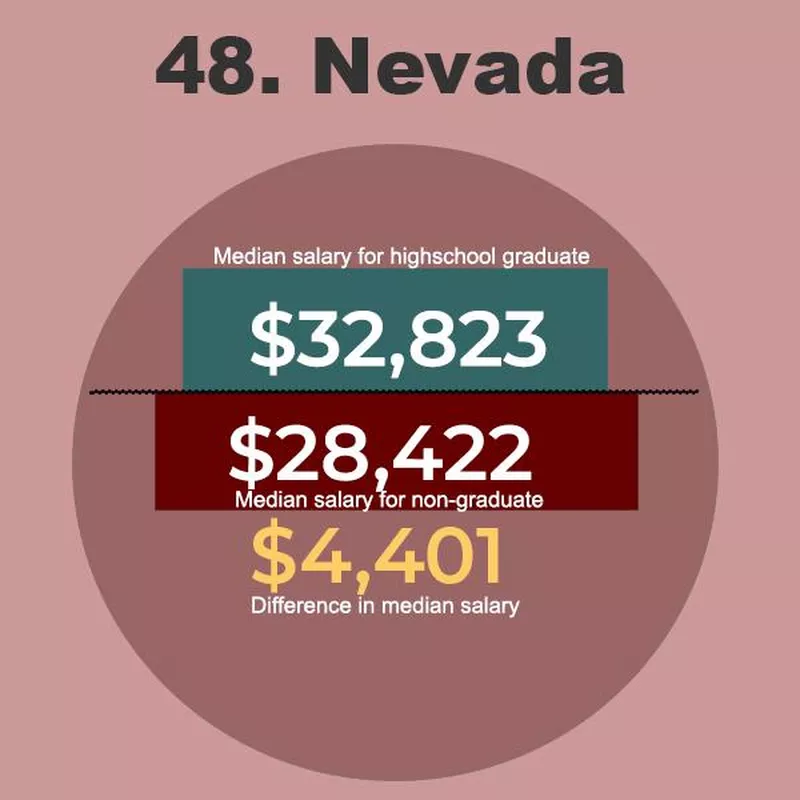
Who needs a high school diploma when you have an endless stream of tourists willing to spend money on dining, partying and gambling? We’re only half-kidding since tourism and gaming are critical to the Nevada economy thanks to fabulous Las Vegas.
Like Idaho, the high school graduation rate in the state is relatively low: about 87 percent. Besides tourism, manufacturing and mining provide jobs for non-graduates, though Nevada’s other big industries — which include aerospace and defense, information technology and health — usually require advanced degrees.
47. Kansas
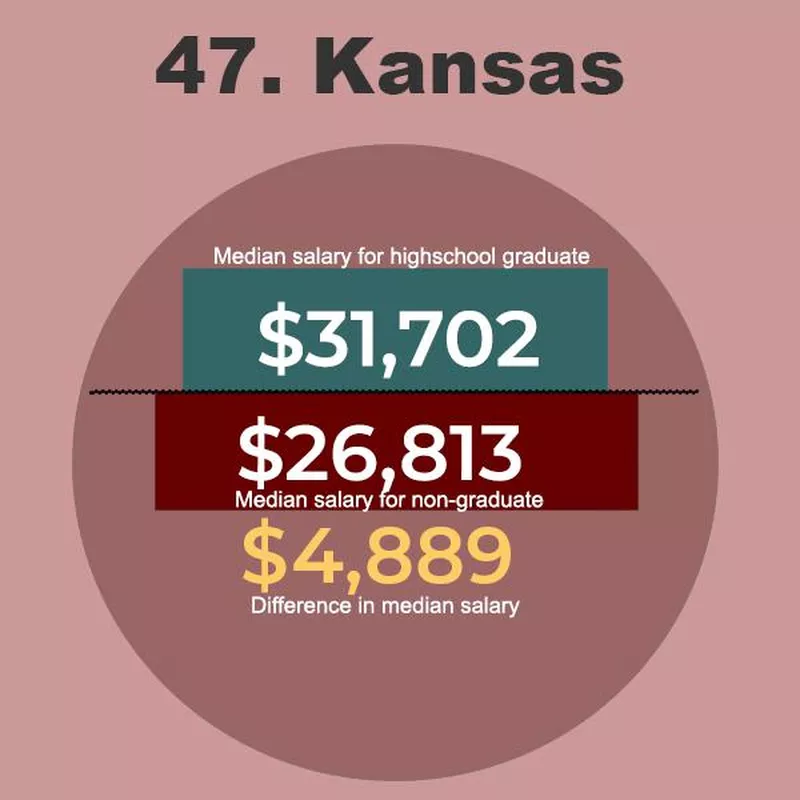
Like Dorothy, Kansas locals without a high school diploma may find that there’s no place like home.
The difference in salary for graduates and non-graduates is about $4,889 — which, while not insignificant, is certainly low compared to the rest of the country.
46. Washington, D.C.
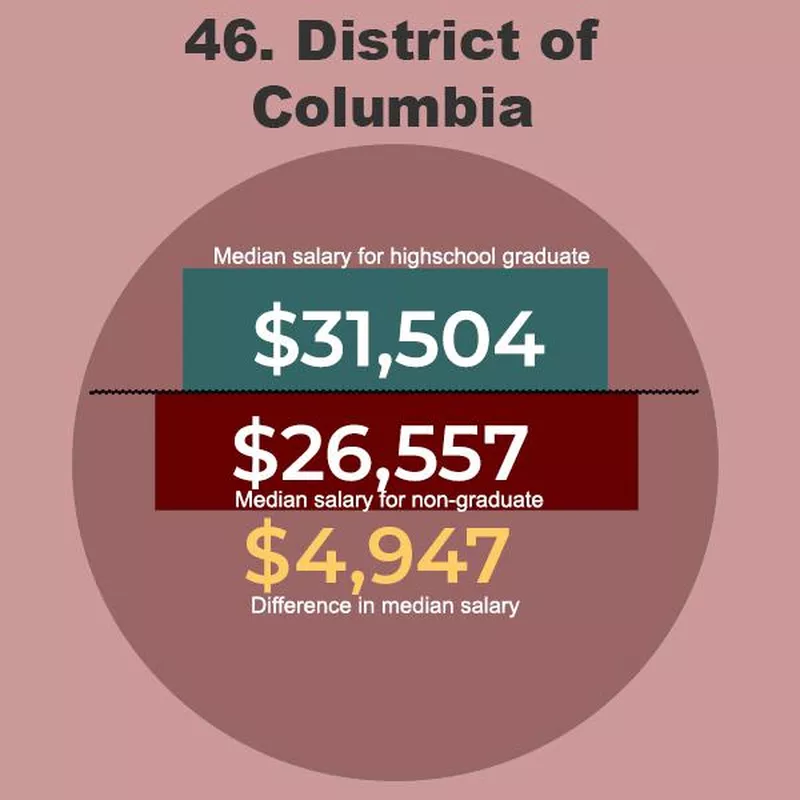
The U.S. capital is notoriously one of the most educated places in the country. This isn’t surprising, given the number of diplomats, consultants and politicians who live here. (Though, as we’ve seen recently, education isn’t much of a requirement for politicians anymore.)
In fact, 21.34 percent of the D.C. population has a master’s degree. You’d expect, then, that graduating high school would be necessary for any job in the capital. But the district’s highly diversified economy and the strong service and tourism sectors provide jobs for people without diplomas.
However, D.C. is also notoriously expensive, and the median non-graduate salary of $26, 557 is not enough for a decent standard of living.
45. Arkansas
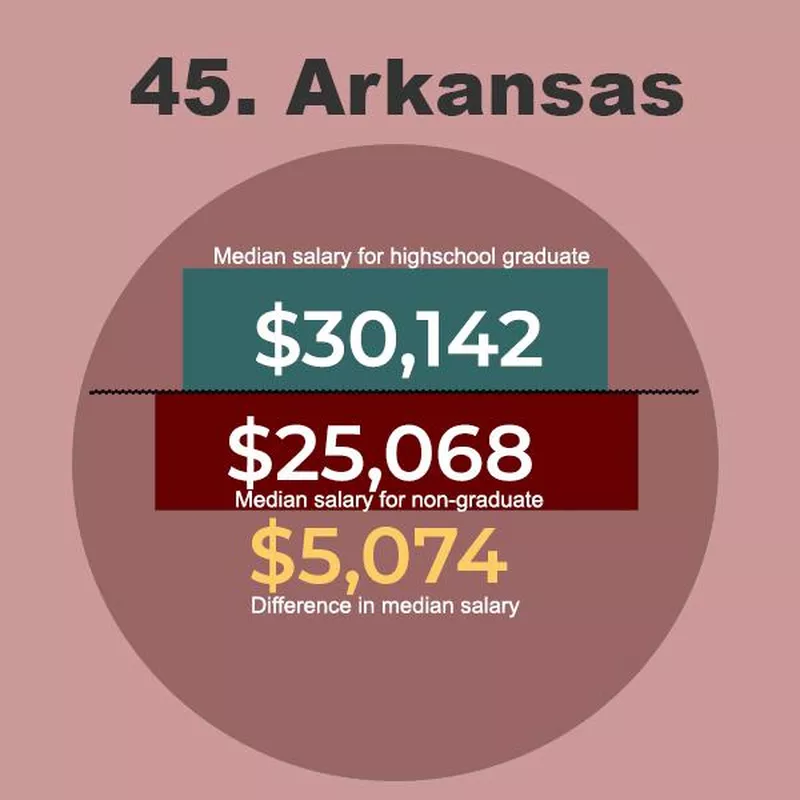
Agriculture is the biggest industry in Arkansas, so a high school diploma is not always necessary.
Graduates will still earn about $5,074 more per year than non-graduates, which isn’t necessarily life-changing, but it’s definitely significant.
44. Vermont
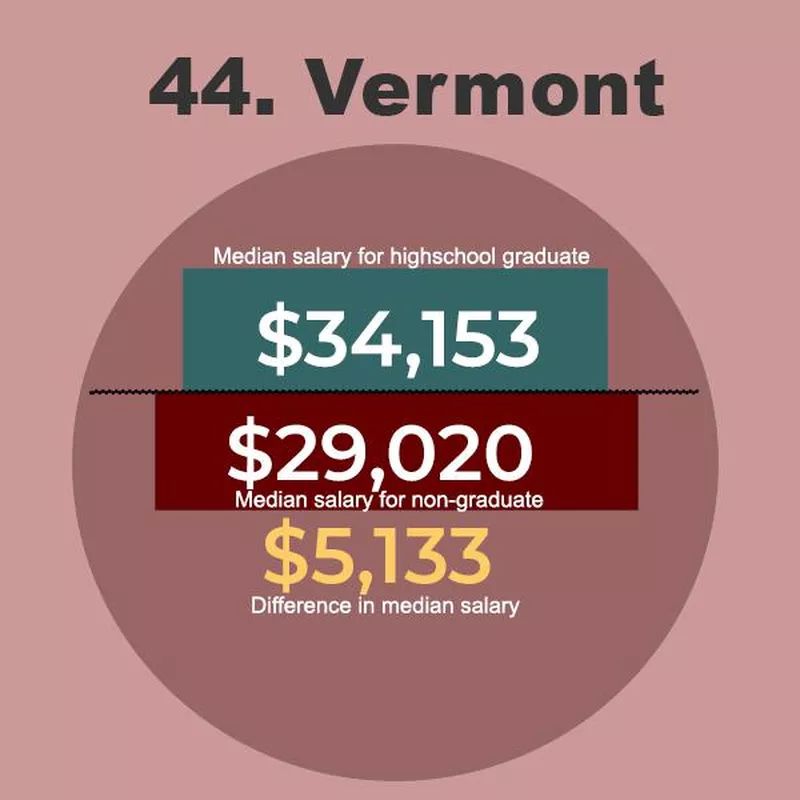
Vermont’s natural beauty, abundant resources and aging population boosts industries like healthcare, manufacturing and real estate.
Hospitals make more profit than any other business in the state. And while higher-level positions certainly require years of education, hospitals also create the need for service and custodial jobs that non-graduates can take.
43. South Dakota
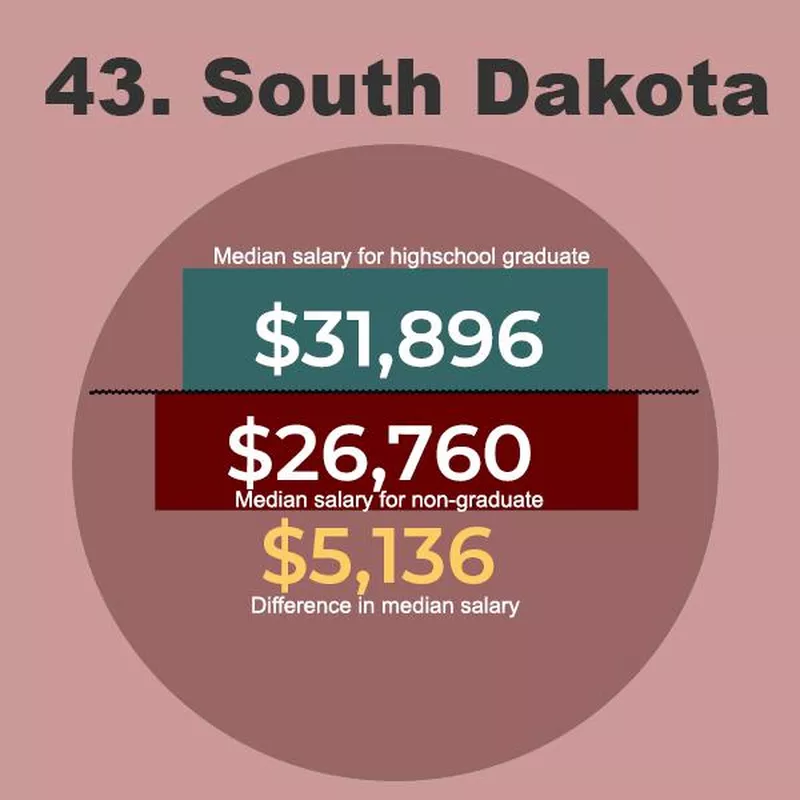
A highly rural estate, many people in South Dakota have jobs related to agriculture, forestry, fishing and hunting. These usually require hands-on experience rather than advanced degrees (with the exception of some positions like agricultural engineers), and employers likely don’t care whether people took calculus and chemistry.
Still, 90 percent of South Dakota residents graduate high school.
42. Oregon
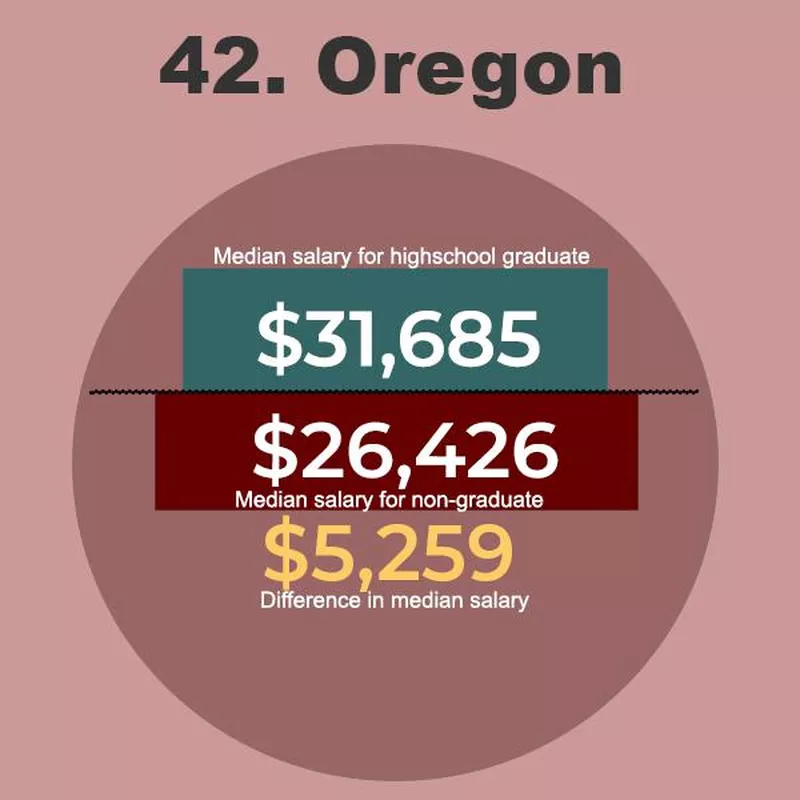
If you want to enjoy a good life in the outdoors without secondary education, Oregon might just be the place for you. The state relies on real estate, manufacturing and healthcare. As we’ve seen, these are industries that open doors for non-graduates.
The cost of living outside of big cities like Portland is also bearable.
41. Utah
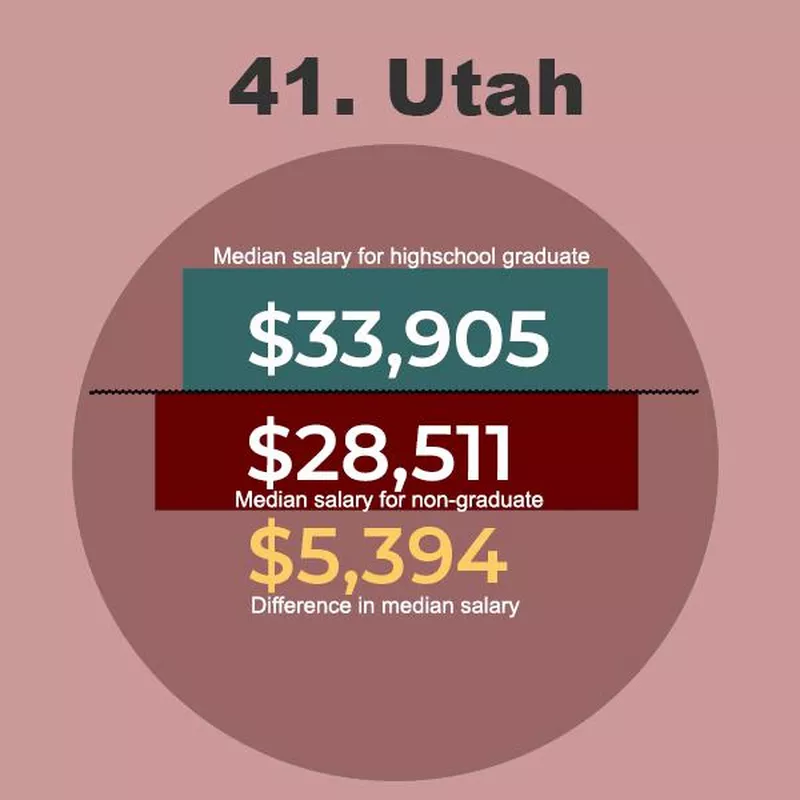
Utah follows a familiar pattern for states where non-graduates aren’t penalized as much: It has a high graduation rate, and its main industries include manufacturing and real estate.
Economic prospects vary widely depending on where you live in the state. There are plenty of opportunities for wildlife and nature guides, given the five national parks and numerous other areas for outdoor recreation.
40. Wisconsin
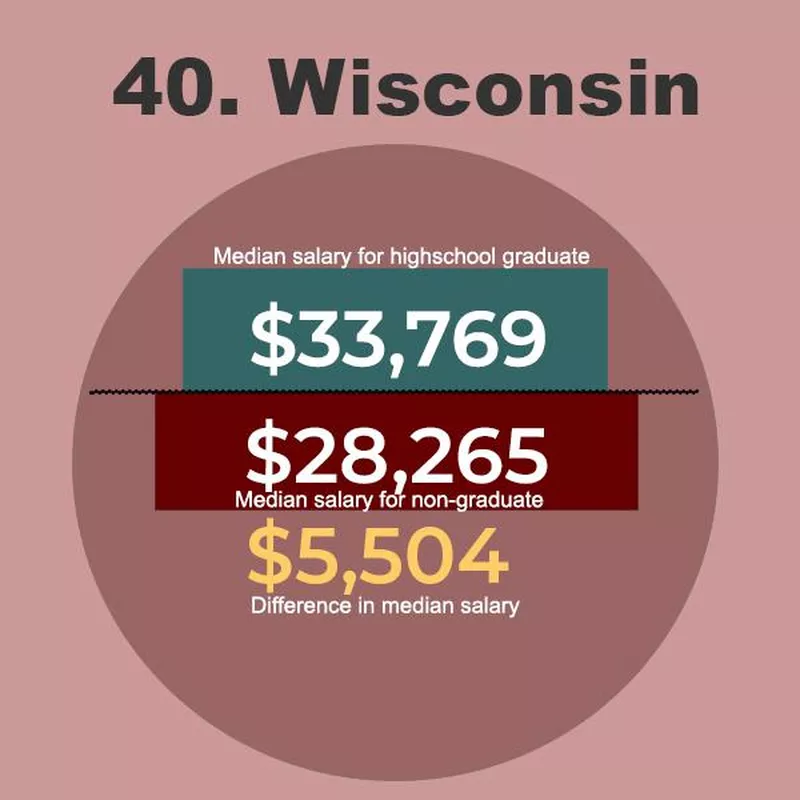
The top cheese-producing state in the U.S., Wisconsin has a gigantic agricultural industry. Many people work on their family’s farm, but there are also jobs at industrial farms that don’t require a degree and put more emphasis on real-world experience.
Manufacturing and tourism are other big economic players that offer employment.
39. Montana
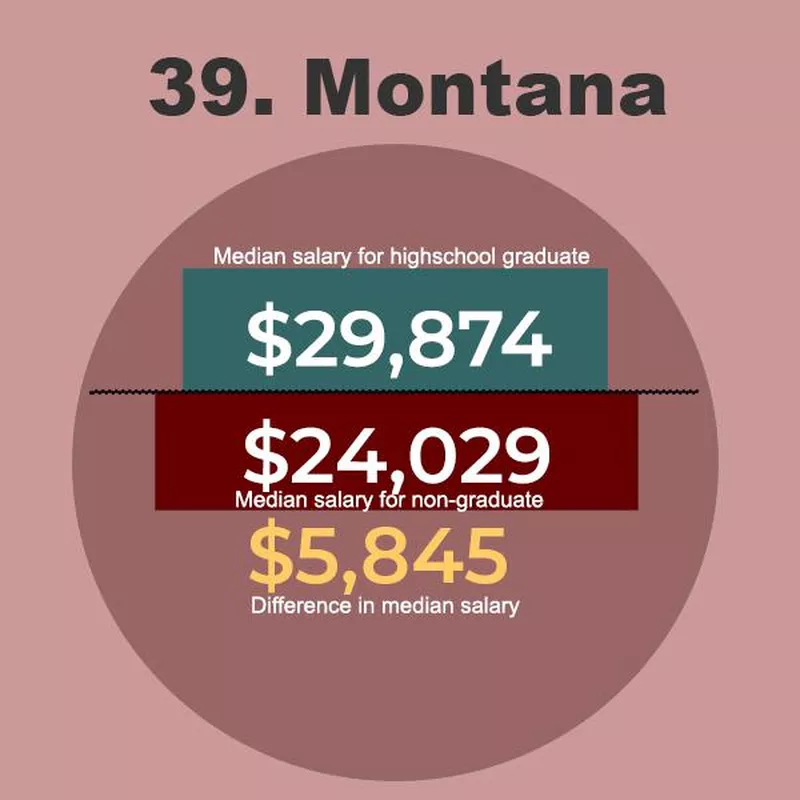
With a high school graduation rate of 88 percent, Montana ranks lower than other rural states in the region. People without degrees can find jobs at both working farms and dude ranches geared toward tourism. Mining and manufacturing are some of the more popular industries to work for if you don’t have a degree.
Post-pandemic, the real estate market in Montana has been booming, which has increased the demand for real estate agents. While this job does require a license, applicants in Montana need to only have completed 10th grade.
38. Colorado
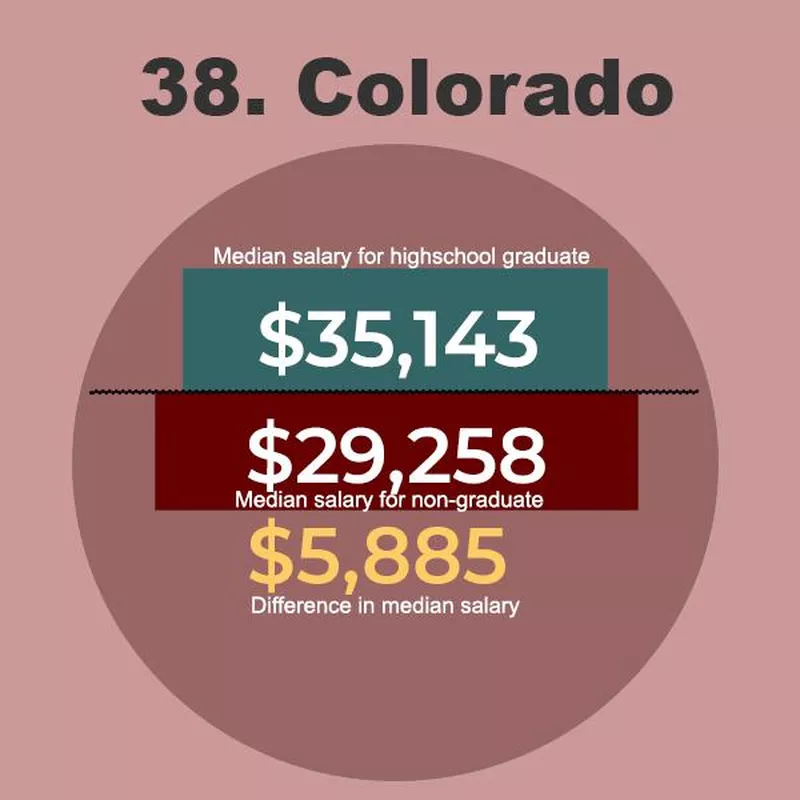
Even though it has wildly expensive cities like Boulder, Colorado is mostly made up of ranches, farms and mines. It may be difficult to live in an urban center with the salary of a non-graduate, but people can find decent jobs in the often-overlooked rural parts of the state.
Of course, tourism also provides opportunities for nature guides who need knowledge of the terrain more than they need to have passed English literature.
37. North Dakota
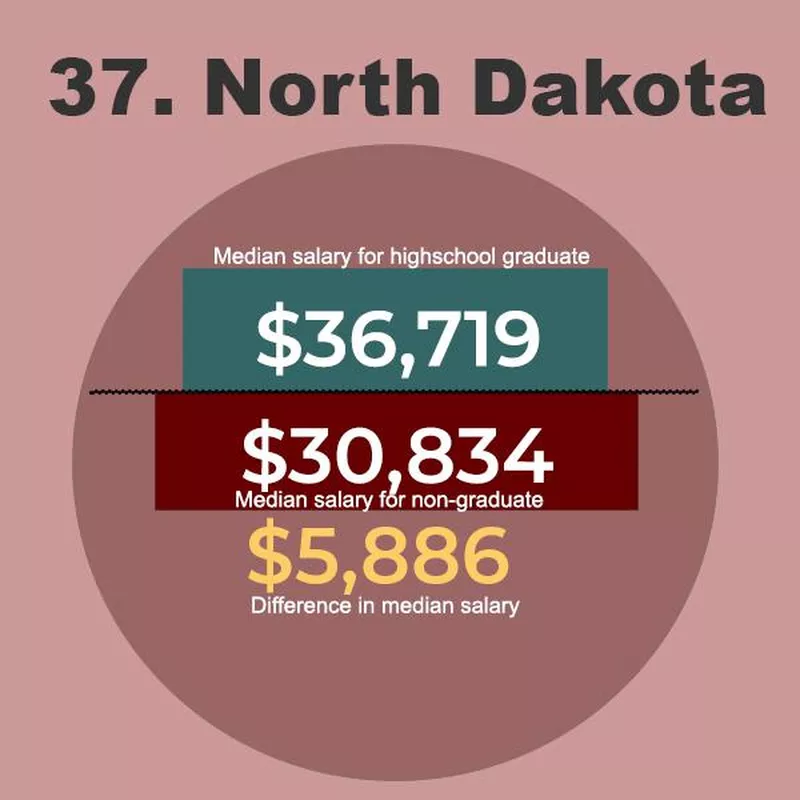
Non-graduates have the highest earning potential in North Dakota, with a median salary of $30,834. But that’s still $5,885 less than people with a diploma make per year.
Agriculture and mining are the state’s key industries.
36. Oklahoma
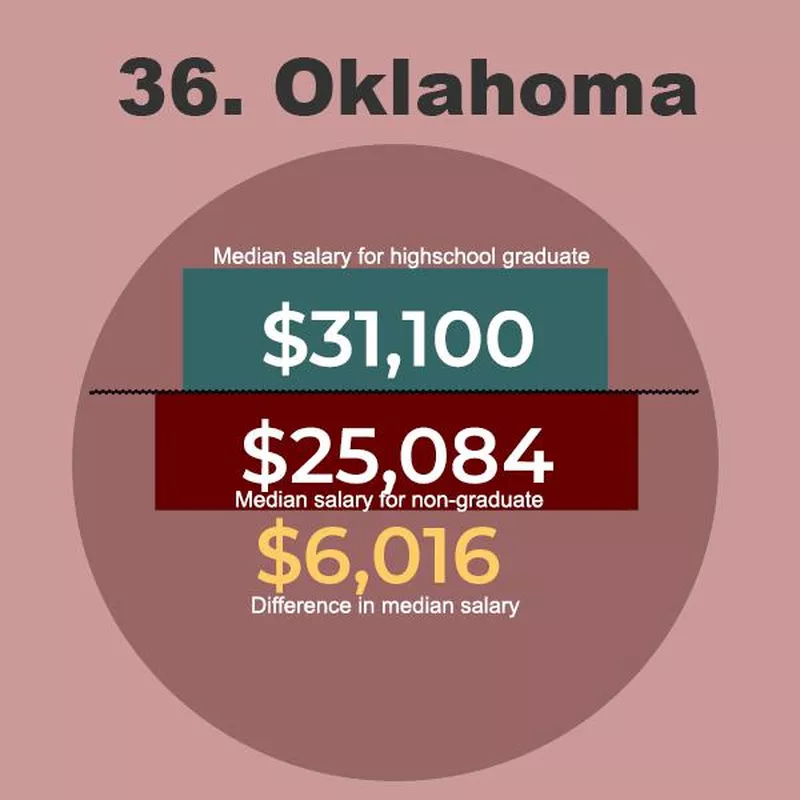
Despite its predominantly rural nature, Oklahoma’s economy doesn’t rely on agriculture as much. While this is still an important economic activity, the state also focuses on specialized industries. After all, it’s home to the largest facilities for aircraft maintenance, repair and overhaul.
While it’s not the worst state for non-graduate employees, the value of a diploma here is the first on this list to be more than $6,000.
35. Maine
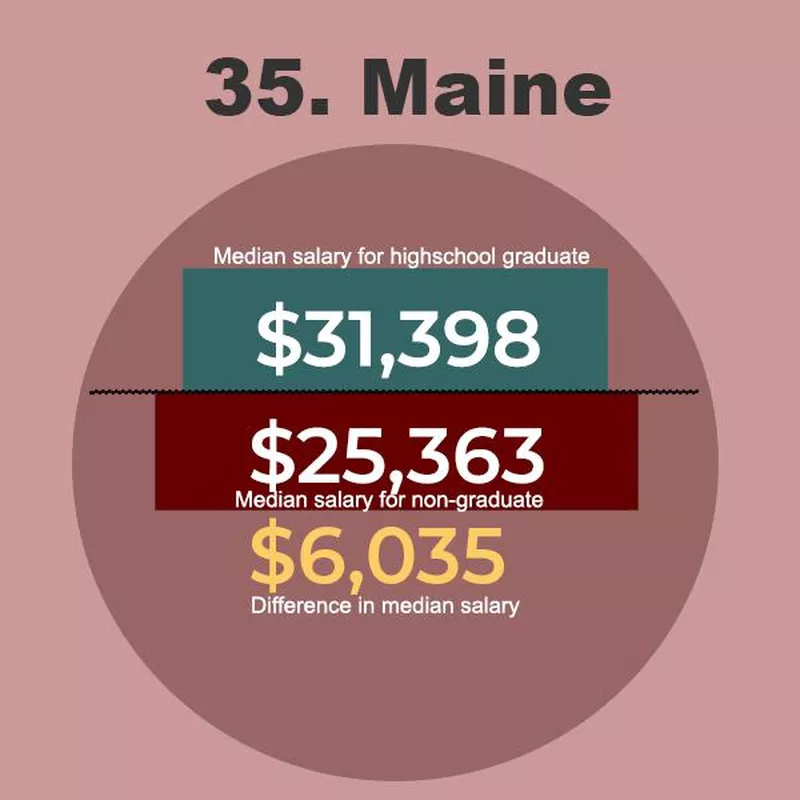
Only about 85 percent of people graduate high school in Maine. And while that’s far from the lowest rate, it’s not great either.
Known for its light house-filled coastline, Maine is actually made up mostly of expansive farmlands. Still, those looking for jobs near the coast or in the state’s cities would do better with a diploma.
34. Georgia
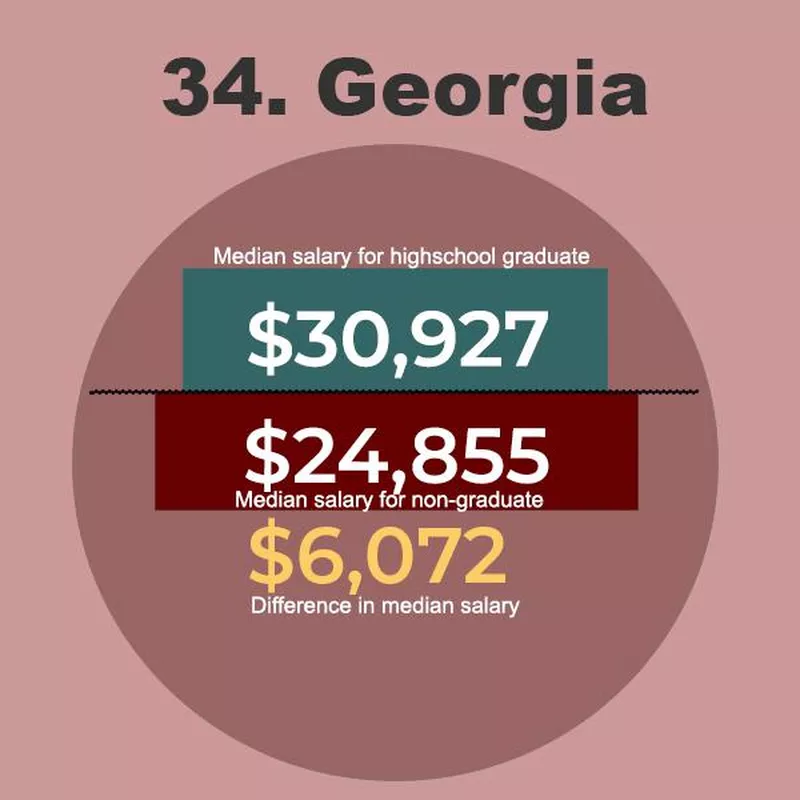
Georgia’s capital, Atlanta, is one of the country’s most important cities and a center for all kinds of industries. The state thrives on pharmaceuticals, car sales and hospitals, though areas like tourism and film also boost the economy.
Much of the state is rural, so people also have the opportunity for jobs at farms or outdoor centers without needing a degree.
33. Florida
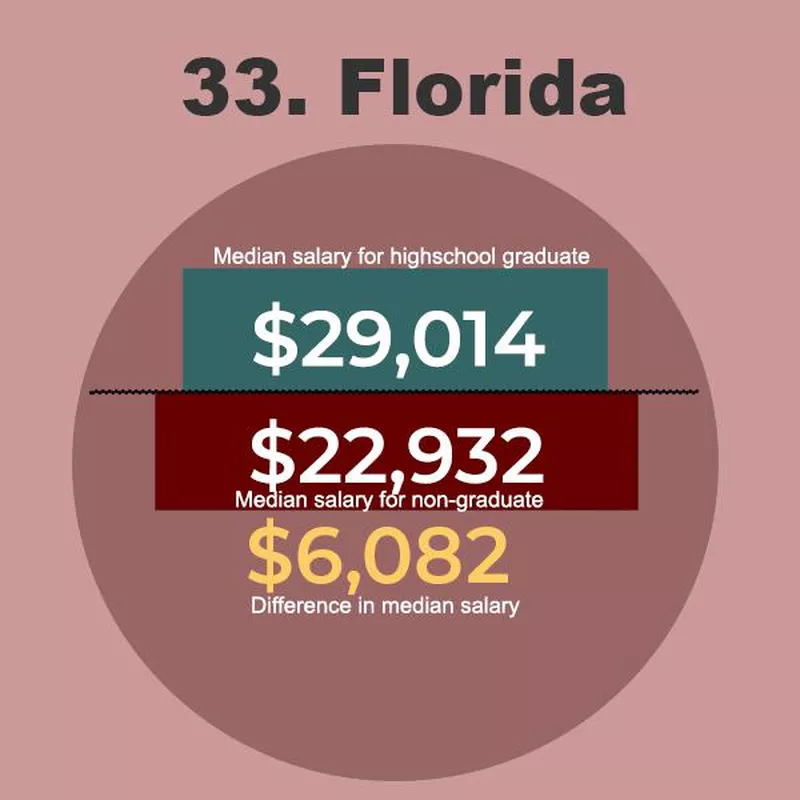
With a large immigrant population, South Florida has opportunities for people who have to drop out of school to support their families or for those whose degrees aren’t necessarily validated in the country. In cities like Miami, Tampa and Jacksonville, hospitality and service thrive. Commercial fishing and farming are also significant economic activities.
Non-graduates make $22,932 a year in Florida. This might be enough to survive in some parts of Florida but not in the big cities that have most of the jobs.
32. Illinois
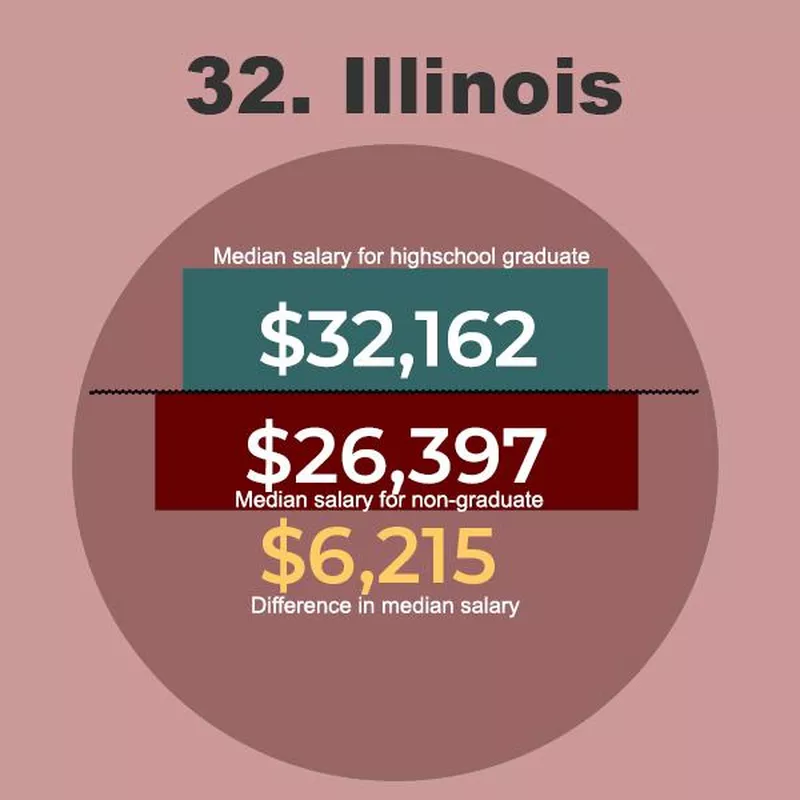
Chicago brings economic diversity to the otherwise primarily rural Illinois. Finance and insurance come out as top industries, which isn’t surprising given the importance of the city.
But the state also has manufacturing and real estate, which makes it an average state for non-graduates to live.
31. North Carolina
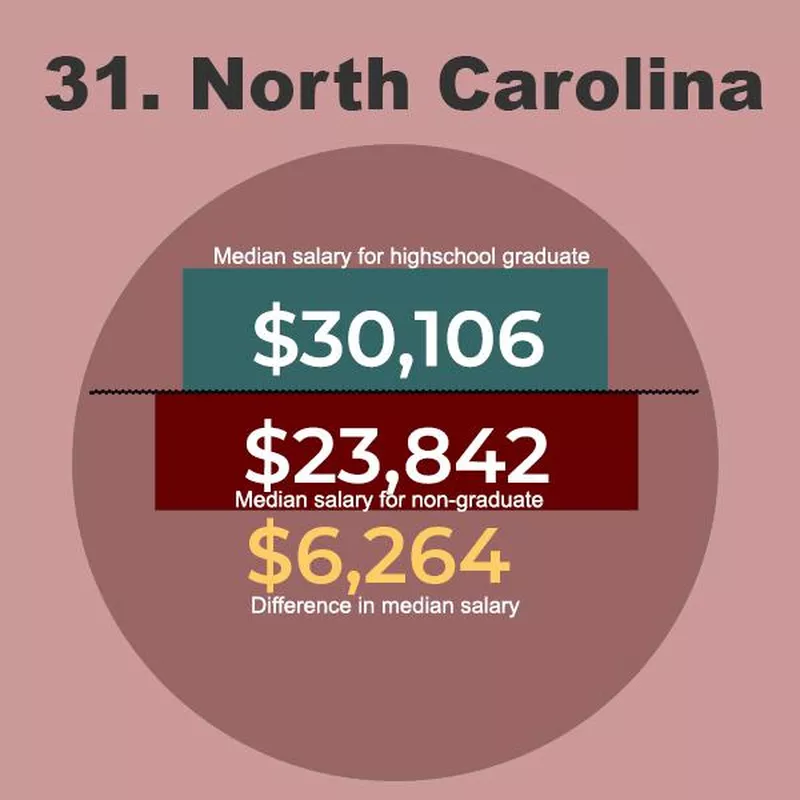
Like Illinois, North Carolina’s economy is impressively diverse. Home to the Research Triangle, the state is a center for research, education and information technology. In these industries, non-graduates will find themselves at a disadvantage.
But the agricultural, automotive and tourism sectors are also vital, meaning that residents can still find plenty of jobs that don’t require a degree.
30. Missouri
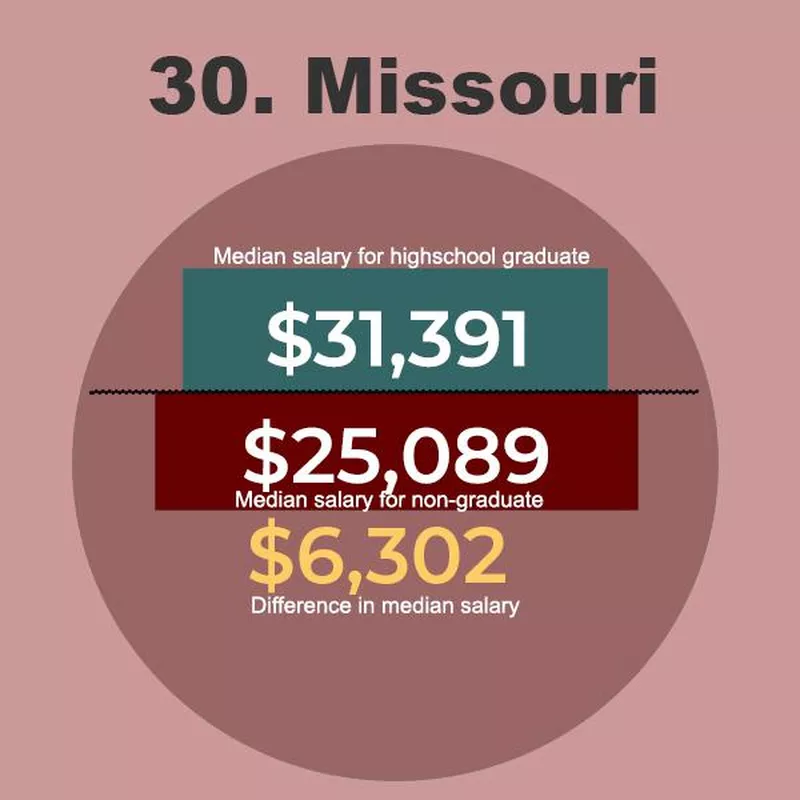
The automobile industry is important to Missouri, with manufacturing and dealerships being some of its top economic drivers.
Hospitals and insurance providers are also large employers. And in several parts of the state, the median salary of $25,089 for non-graduates is enough for a single person to live somewhat decently.
29. Texas
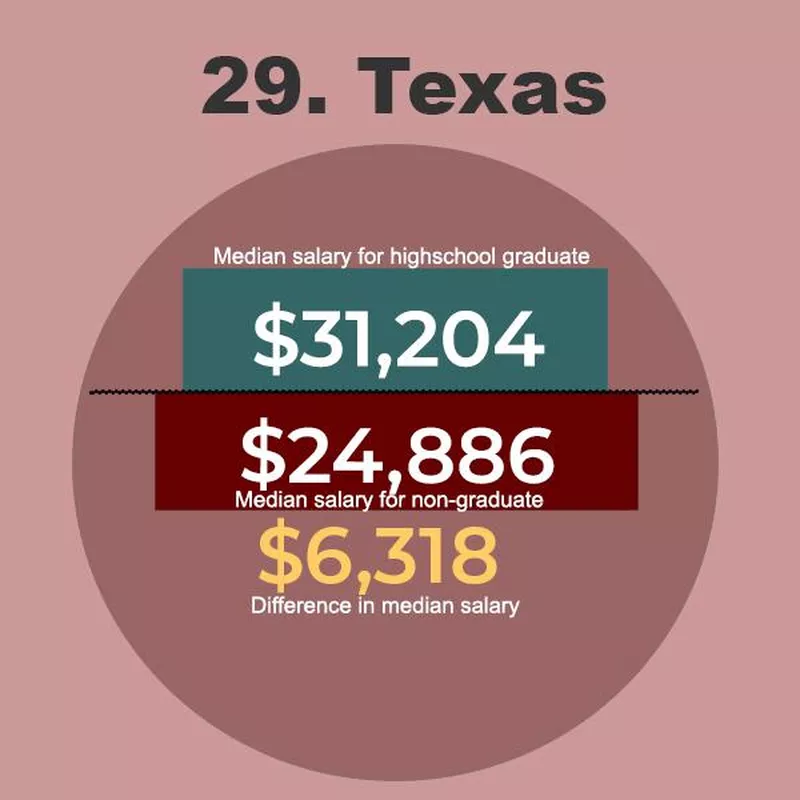
Along with Iowa and Kentucky, Texas has the country’s highest high school graduation rate (94 percent). The meat-heavy state has numerous cattle and horse ranches but also large metropolises like Houston and Dallas. This gives it economic diversity that is advantageous for non-graduates.
Just note: A number of highly skilled workers are coming into the state, following numerous start-ups and companies that have left California’s Silicon Valley to set up shop here.
28. Arizona
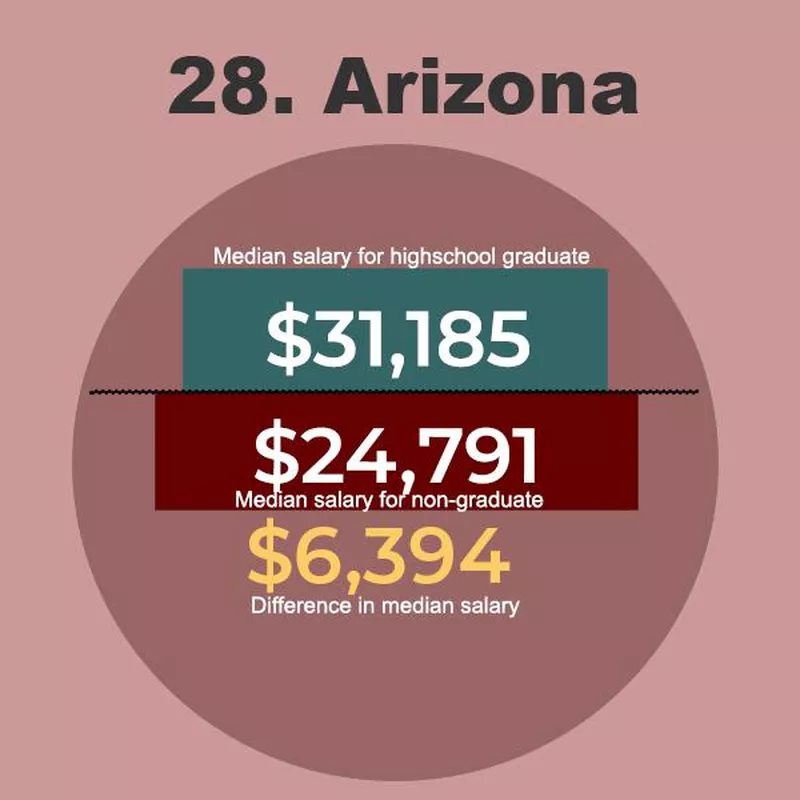
In contrast to Texas, Arizona has the lowest graduation rate of any state. Only 74 percent of the population has a diploma. This may be partly due to the large number of immigrants who reside in the state and don’t have the opportunity to complete their studies.
Agriculture, mining and tourism provide jobs to the 26 percent of residents who don’t have a high school diploma. Walmart is the second-largest employer after the state government. While this represents the opportunity to work, employees rarely receive benefits like health insurance and paid time off.
27. Indiana
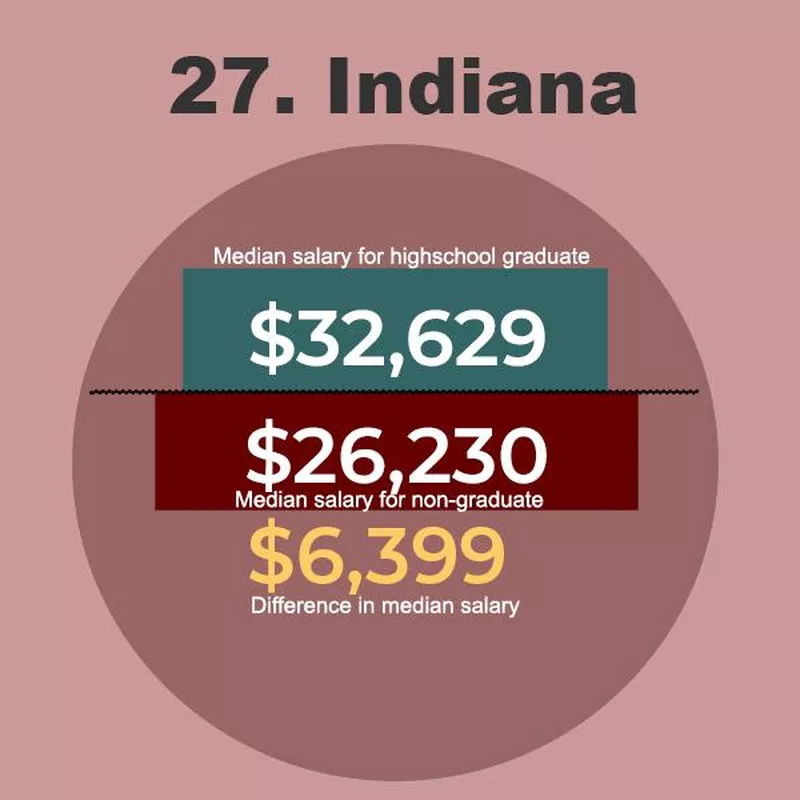
Like other Midwestern states, Indiana relies on real estate, manufacturing and healthcare.
The difference between the salaries of high school graduates and non-graduates is about $6,400, which is fairly comparable to neighboring states like Missouri and Illinois.
26. Hawaii
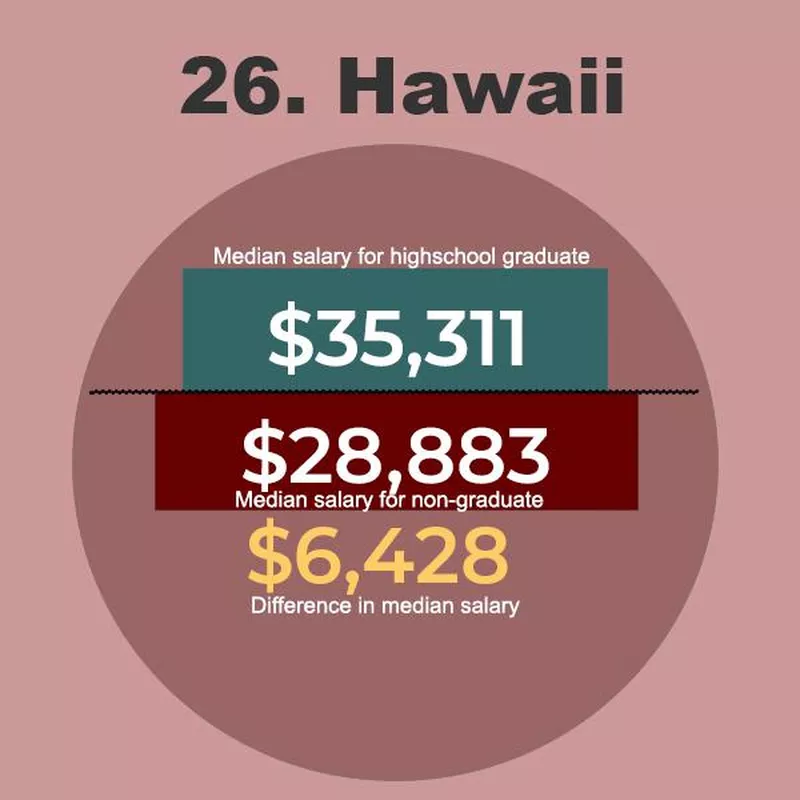
Not surprisingly, tourism is Hawaii’s largest industry. The state is notorious for its high cost of living and lack of affordability. This is aggravated by the fact that only 81 percent of the population has a high school diploma.
Since many people can’t find jobs outside of service and tourism, many drop out to start working earlier since graduating isn’t a requirement for work. However, the median non-graduate salary of $28,883 is barely enough to get by in Hawaii.
25. New Mexico
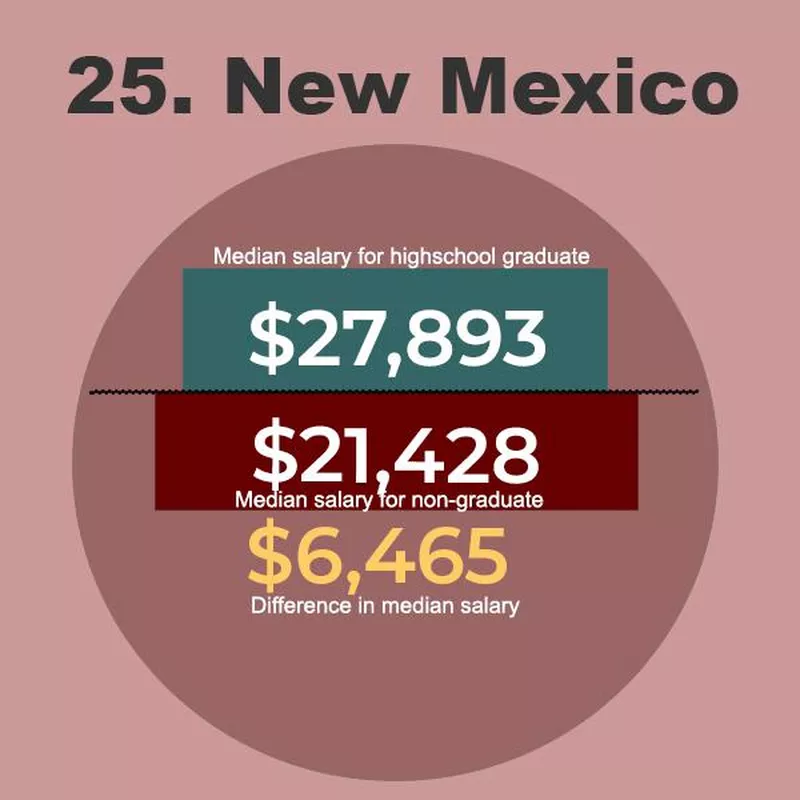
New Mexico has the lowest median salary for non-graduates out of any state. It also has the second-lowest graduation rate, which sits at about 78 percent.
The state’s cost of living is relatively low, but living off of $21,428 would be a struggle anywhere in the U.S.
24. Pennsylvania
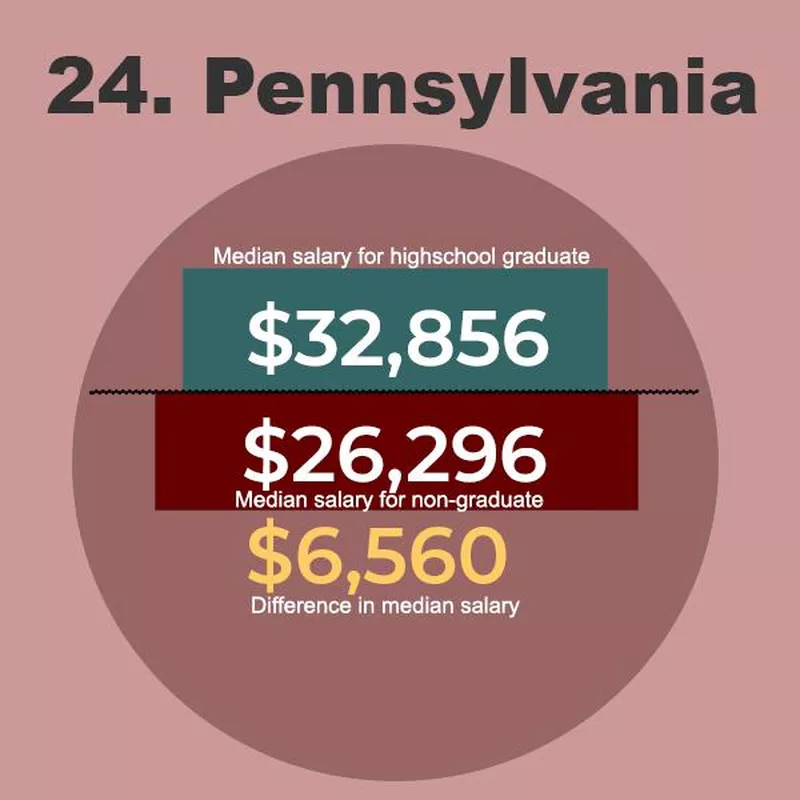
A Rust Belt state, Pennsylvania still relies on manufacturing as well as agriculture. But since its heyday, it’s also started to focus on energy production, medical technology and robotics. This has raised the value of a high school diploma — and advanced degrees.
While the median salary for non-graduates isn’t decent compared to that of other states, residents certainly benefit from having a diploma.
23. Tennessee
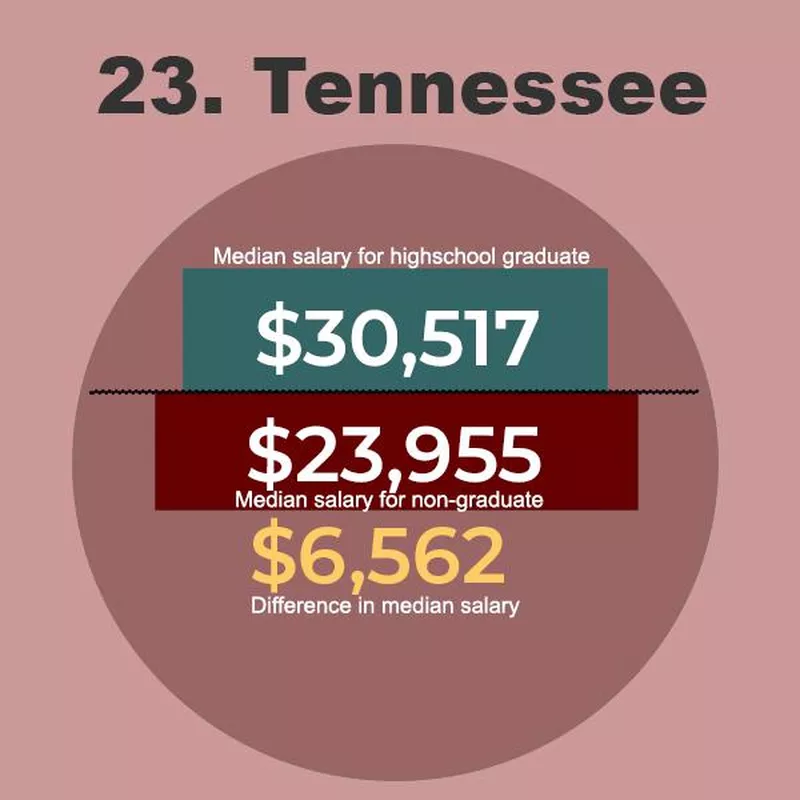
Tennessee follows a similar pattern as other rural states, with a good high school graduation rate and a focus on sectors like mining and manufacturing.
And yet the income gap is higher than in states with comparable circumstances. The median salary, which is almost $24,000 leaves much to be desired.
22. Delaware
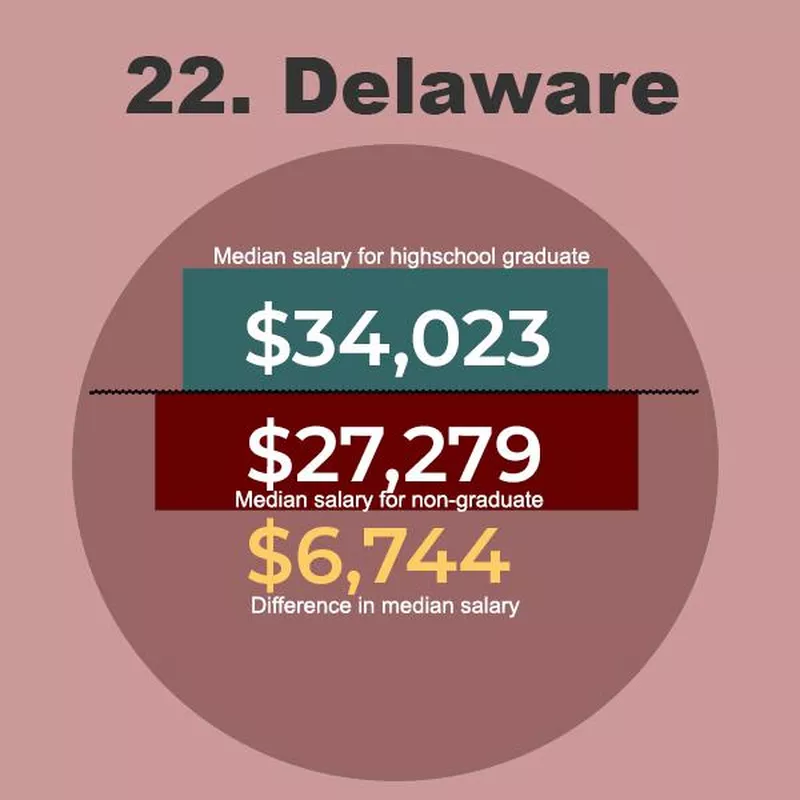
Delaware’s small size limits its economic activity as well as the number of available job positions. With competition being tougher, it makes sense that people with a diploma would be at an advantage over people without one.
Business cost is low in the state, so people can engage in various jobs ranging from manufacturing to healthcare.
21. Virginia
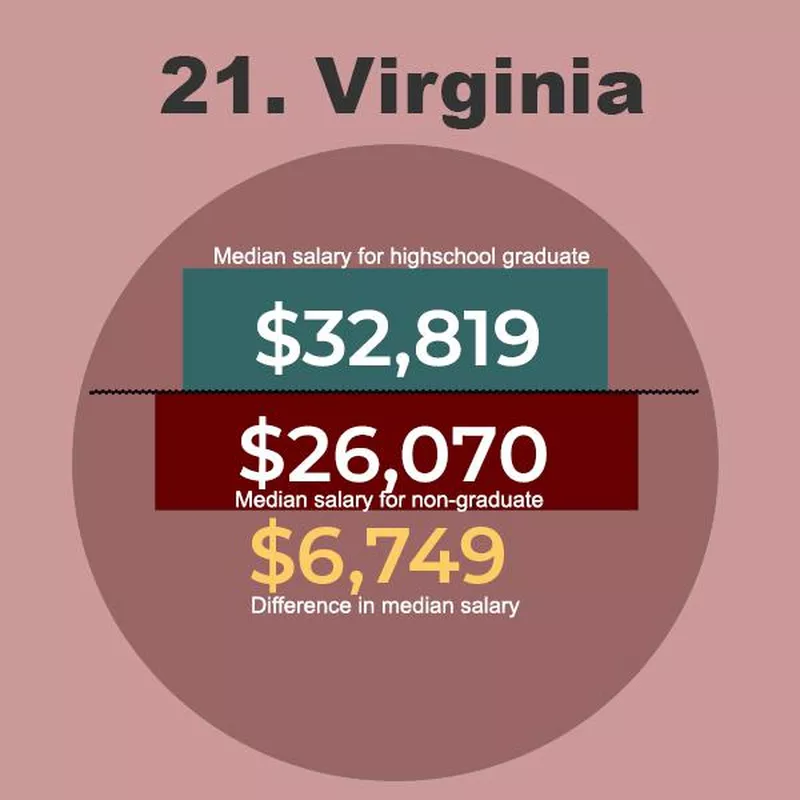
Virginia — especially in the north — has one of the best secondary education systems in the country. It’s no surprise that 93 percent of students graduate. What is surprising is seeing the state place much higher than Washington, D.C., given that many people in Northern Virginia work in D.C.
The rest of the state is decidedly more rural, with the exception of cities like the state capital, Richmond. You’d expect tourism and agriculture to provide decent jobs for people that have not graduated high school, but a diploma continues to be quite valuable here.
20. Mississippi
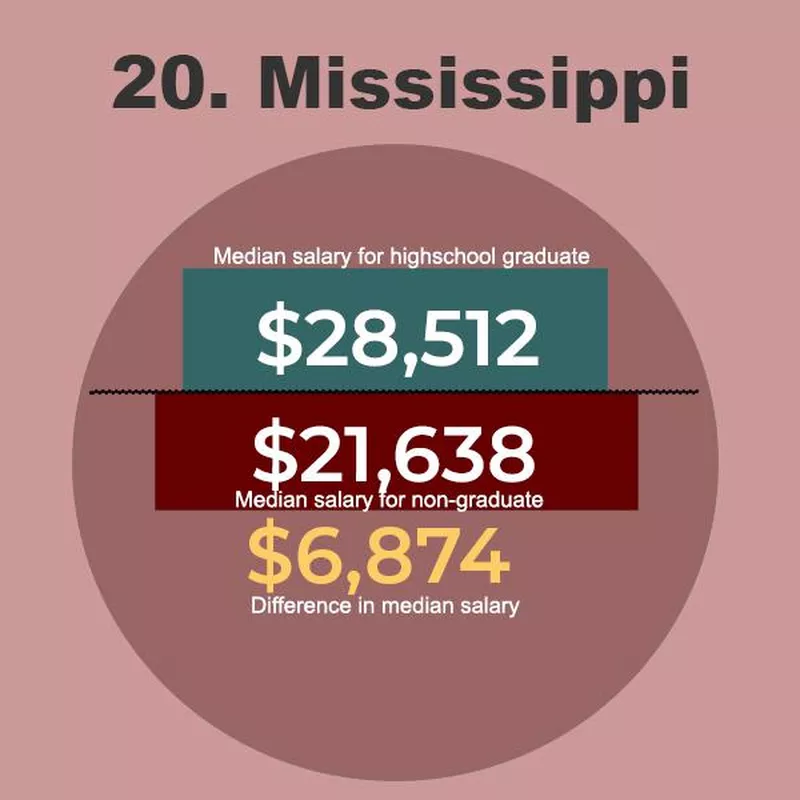
After New Mexico, Mississippi has the lowest median salary for non-graduates. The salary for people with diplomas also falls behind that of most other states.
Given that Mississippi has the highest poverty rate in the U.S., we can assume that wages are low for everyone. But non-graduates are hit the hardest, as their access to labor opportunities is more limited.
19. Minnesota
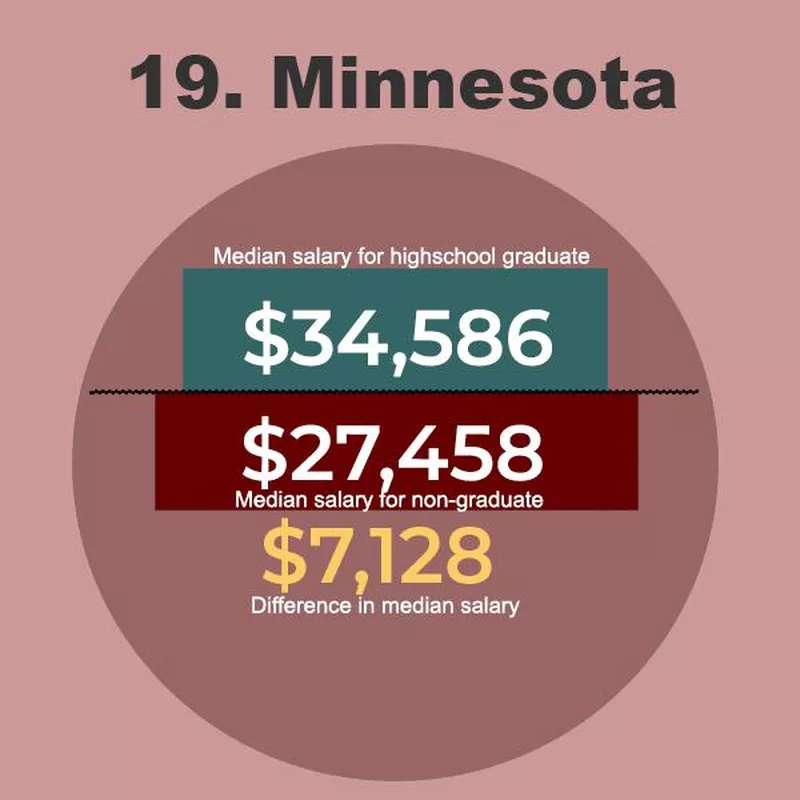
Minnesota is the first state where the difference in median salary surpasses $7,000. While non-graduate earnings are similar to those of other Midwestern states, high school graduates in the state earn more than their counterparts in the region.
The state’s focus on renewable energy production, life sciences and clean tech may have something to do with this gap.
18. California
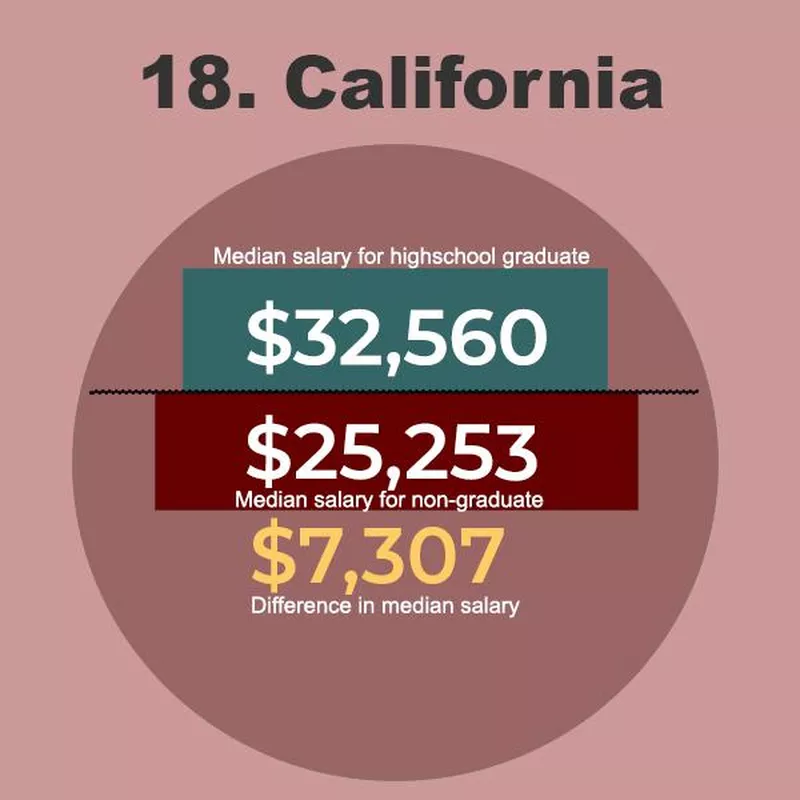
California notoriously suffers from drastic inequality. While many of the world’s wealthiest people live in Los Angeles and San Francisco, the state suffers from a homelessness crisis and has numerous mining towns that are slowly being abandoned for lack of opportunities.
Only 86 percent of students graduate high school, which is a clear disadvantage in this state where nepo babies bribe their way into elite schools.
17. New Hampshire
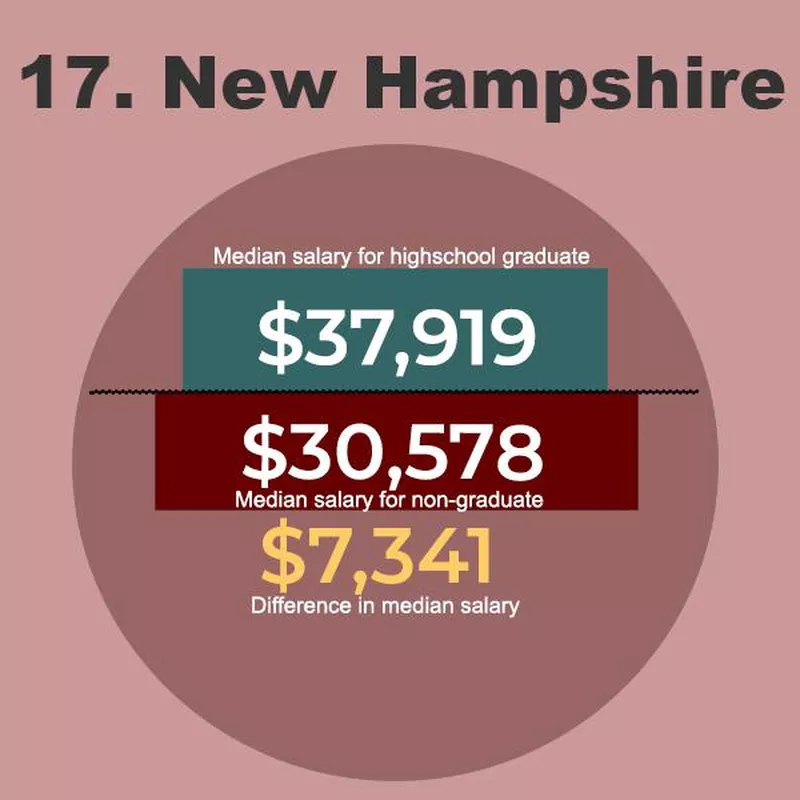
With an 88 percent graduation rate, 12 percent of New Hampshire residents face significant wage losses over the course of their life. Technology, health sciences and advanced manufacturing bolster the local economy, providing high earning potential for people who graduate high school or pursue higher education.
That said, the state offers the second-highest median salary for non-graduates. So while the gap is wide, earning potential is still decent even without a diploma.
16. Rhode Island
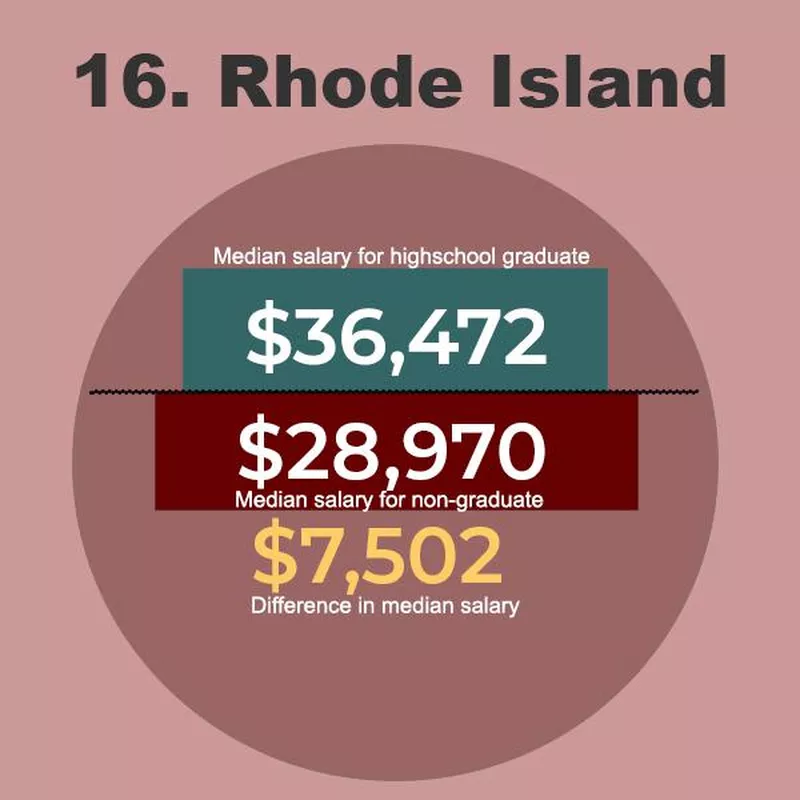
Despite its small size, Rhode Island has found a way to diversify and strengthen its economy. Coastal towns and prestigious universities bring in industries like biomedicine and data analytics, where employees need much more than a diploma.
Non-graduates can find opportunities in tourism and manufacturing but may have trouble covering basic costs with their wages.
15. South Carolina
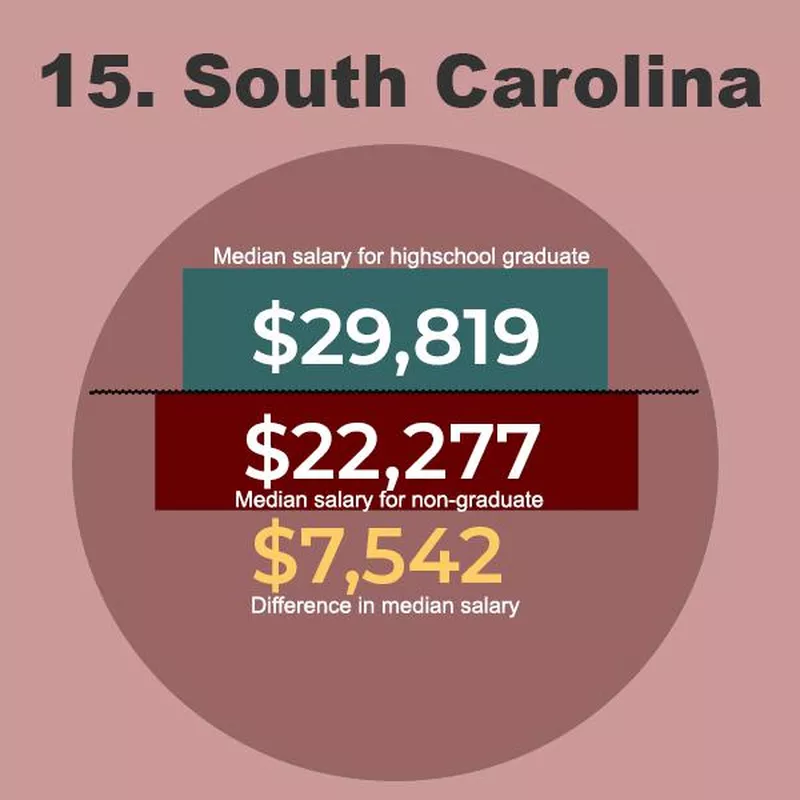
Despite having a nice share of industries like advanced manufacturing, biotechnology, life science and aerospace, South Carolina is one of the poorest states in the country.
Like Mississippi, wages suffer from this economic environment. But if even high school graduates struggle to earn $30,000 a year, non-graduates resign themselves to a median salary of $22,277.
14. Alabama
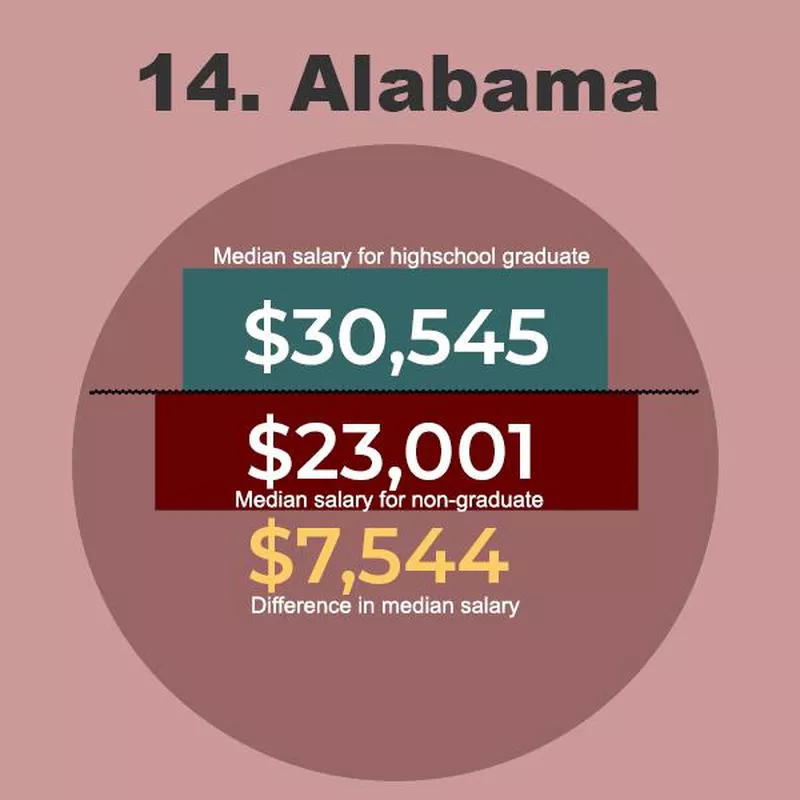
Agriculture and car manufacturing are essential economic activities in Alabama. But the state also focuses on industries like aviation, bioscience and information technology.
This may explain the wide gap between the salaries of people with and without a diploma. As the seventh poorest state, Alabama offers low wages for non-graduates.
13. Washington
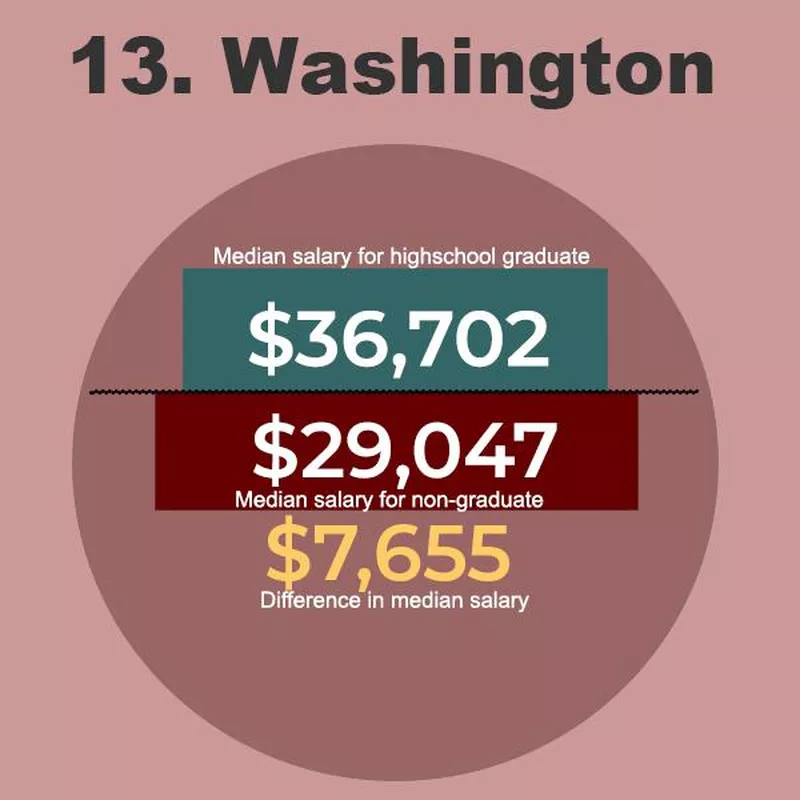
Like Alabama, Washington focuses on agriculture and more technical industries like life science, information technology and clean energy production.
The state is home to Seattle, the headquarters for companies like Amazon, Starbucks and REI. And while these provide jobs that don’t necessarily require a high school diploma, higher-paying jobs would ask for prospecting employees to have one (and, in most cases, at least some college education).
12. Michigan
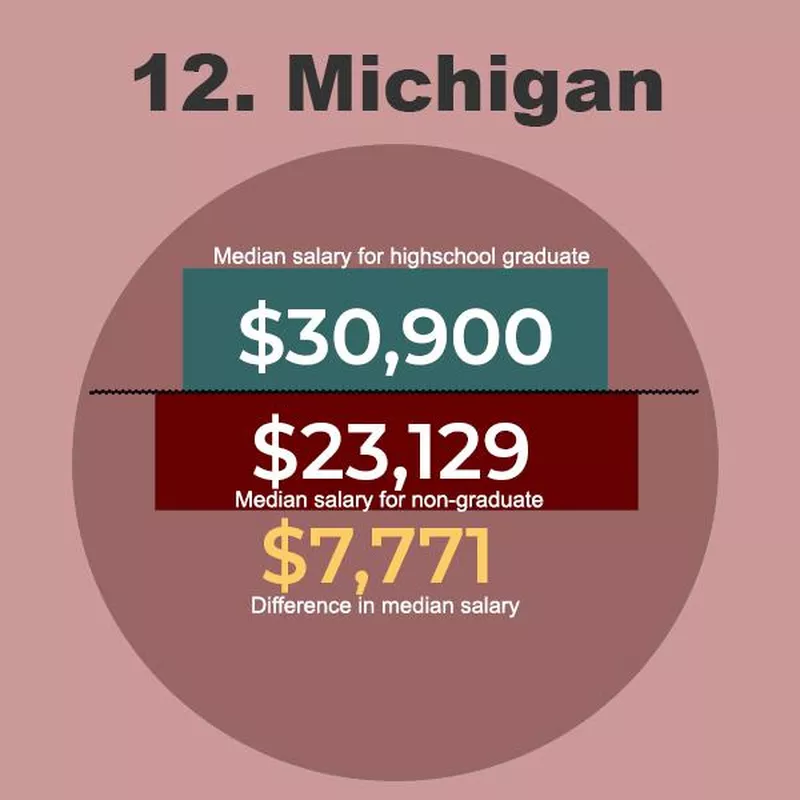
Michigan was hit hard by the economic collapse that affected all Rust Belt states when the automobile industry moved to other countries. Its biggest city, Detroit, is making a comeback after declaring bankruptcy in 2013, but the state still hasn’t fully revitalized its economy.
Agriculture, manufacturing and tourism are Michigan’s largest industries. But while in neighboring states these industries have provided comparable wages for non-graduates, they don’t seem to do so here. Whereas someone with a high school diploma can expect to make almost $31,000 a year, people without one earn a bit over $23,000 — a surprising difference, especially considering that the graduation rate is only 89 percent.
11. Ohio
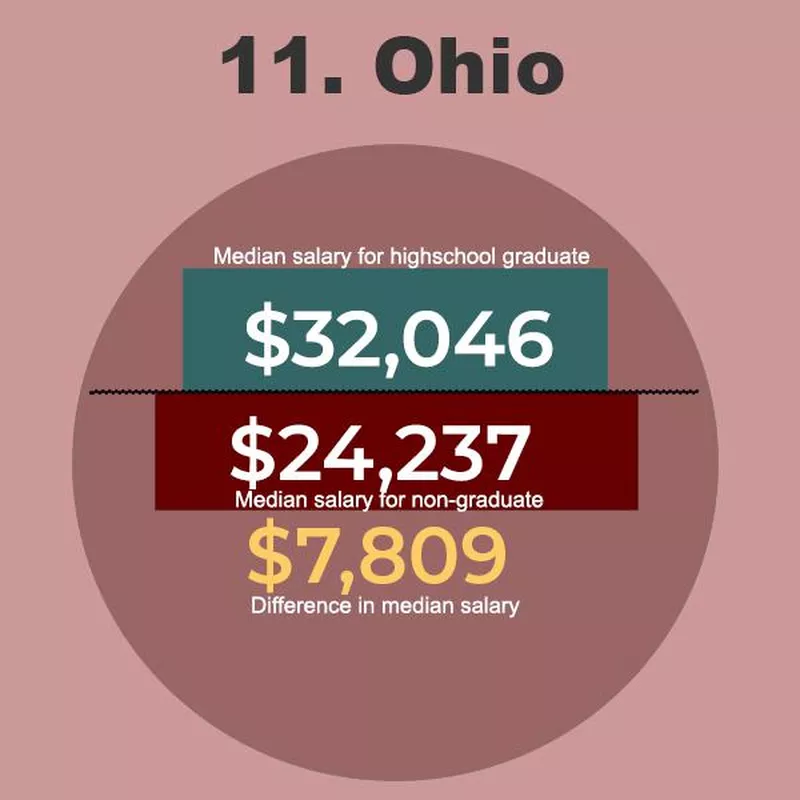
Another Rust Belt state, Ohio still relies heavily on manufacturing. While car production has largely moved overseas, it’s still an important economic activity here, along with manufacturing plastics, fabricated metals and electrical equipment.
But even within these industries, you’ll want to finish high school, as your earning potential will significantly increase.
10. Kentucky
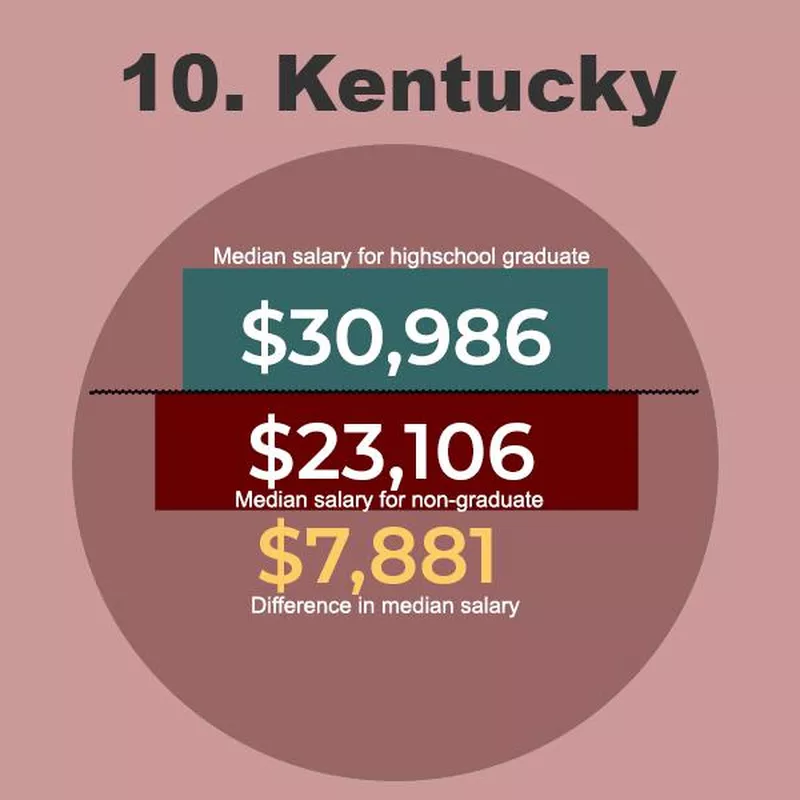
Kentucky ties with Iowa and Texas for the highest graduation rate in the country. But while the 6 percent of non-graduates in the other states weren’t necessarily punished financially for not finishing high school, they take significant losses in Kentucky.
As the fourth-poorest state, Kentucky has a hard time guaranteeing decent wages to its workers. And it seems like non-graduates get particularly left behind.
9. Louisiana
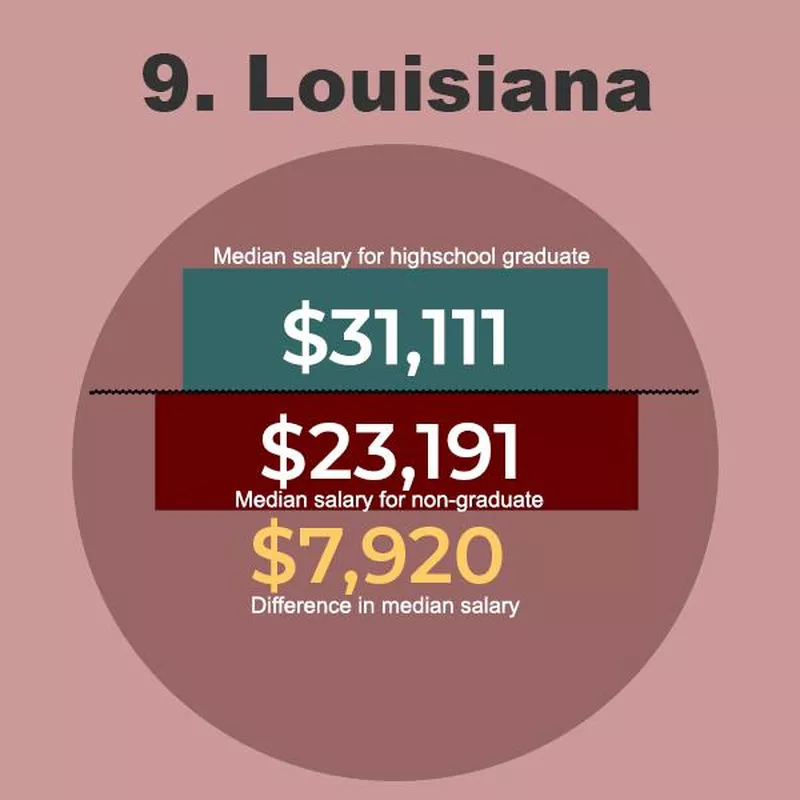
Louisiana has the second-highest poverty rate in the country, and only 83 percent of students graduate high school. Top industries include oil extraction, chemical production (a combination that has created health issues in an area known as Cancer Alley) and coal mining.
Not having a diploma in this state translates to a significant loss of income.
8. Wyoming
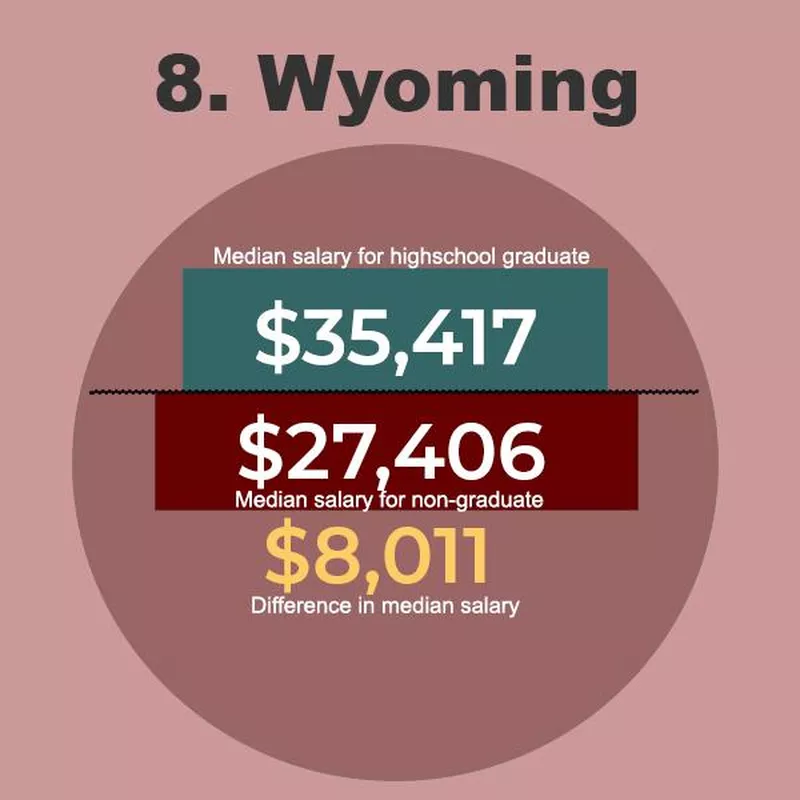
Wyoming’s graduation rate is 82 percent. The state’s most prominent industries revolve around oil extraction and petroleum refining, as in Louisiana.
Even entry-level, low-paying jobs at oil refineries require a high school diploma, so non-graduates have reduced labor opportunities, making $8,000 less per year than their graduated peers.
7. New York
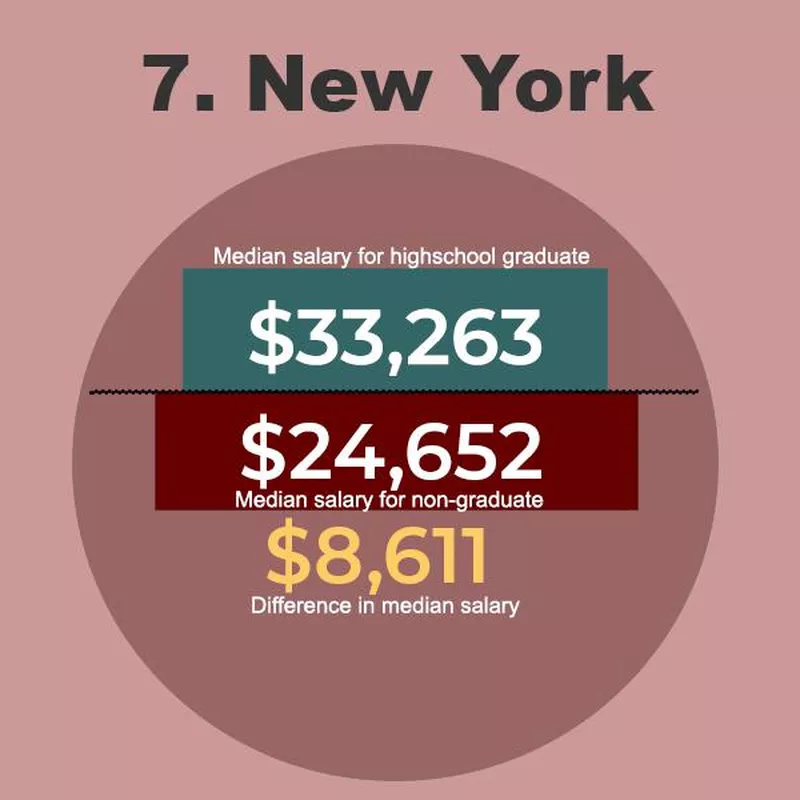
People often forget there is more to New York than New York City. Still, the city is the state’s major economic hub. Case in point: The most profitable businesses in the state are commercial banking, hospitals, portfolio management and investment banking.
Many people in the city rely on the informal economy, but their situation is precarious. Outside of the metropolis, the state still struggles with the collapse of the automotive industry that once upheld cities like Buffalo.
6. Maryland
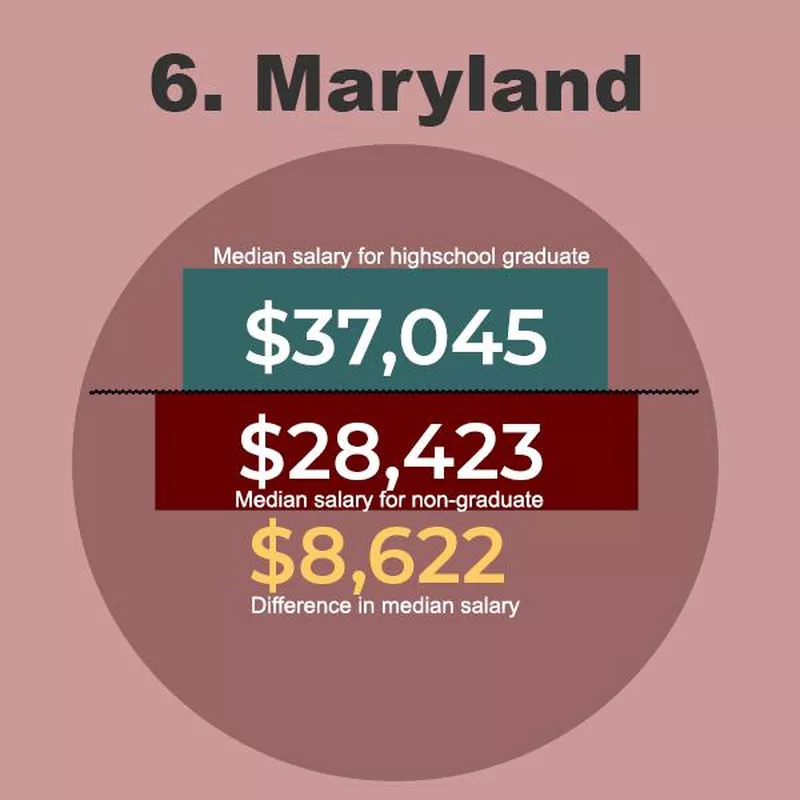
With an 83 percent graduation rate, Maryland differs from neighboring Virginia, despite also providing suburbs to the national capital. Baltimore is the state’s economic center, with a history of shipyard manufacturing.
The state’s leading industries include biopharma, cybersecurity and energy production — all industries in which a high school diploma is usually required. Construction and manufacturing do afford non-graduates opportunities, but these don’t pay nearly as well as other jobs in the state.
5. West Virginia
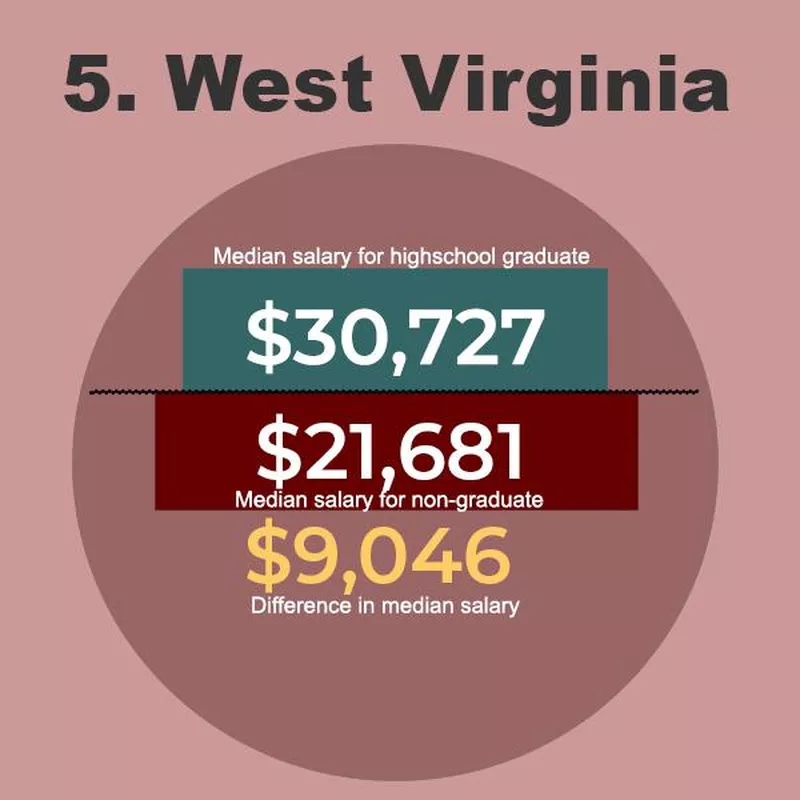
At first glance, West Virginia should be closer to states like Iowa in terms of the wage gap. It has a high graduation rate (93 percent), and its top industries include manufacturing and mining.
But like Mississippi and Louisiana, the state’s high poverty rates seem to affect non-graduates the most. The difference between having a diploma and not having one could cost people more than $9,000 a year.
4. New Jersey
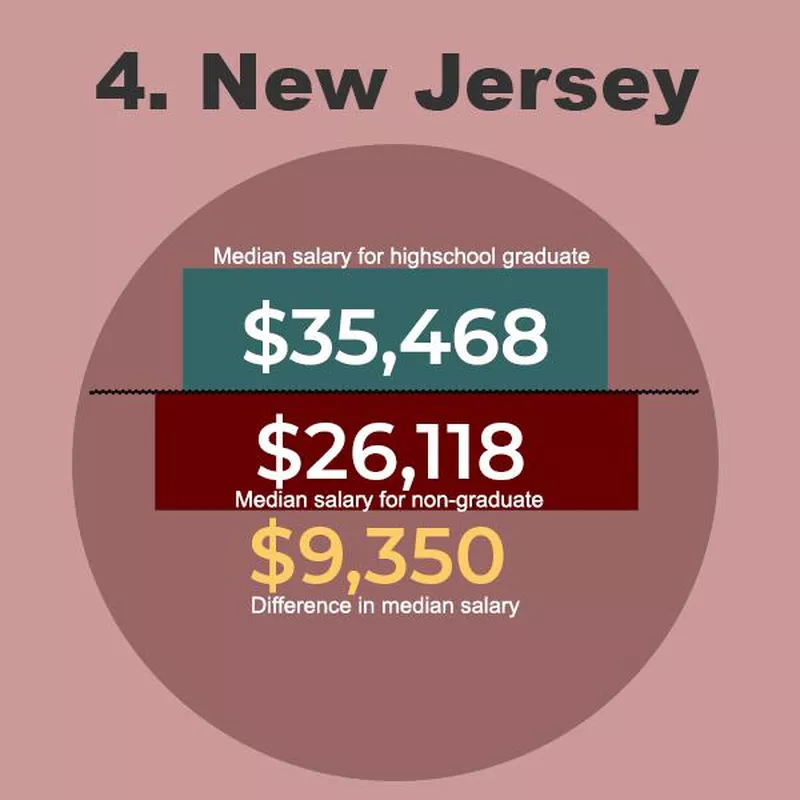
A suburb of New York City, a coastal beach destination and a center for pharmaceuticals and life sciences, New Jersey is a difficult place to put in a single box.
Information technology, transportation and life sciences are some of the most active sectors in the state, which could explain why there are not as many jobs available for people without diplomas.
3. Massachussetts

The home of Harvard University and Massachusetts Institute of Technology (MIT), the state places high importance on education, with around 93 percent of students graduating from secondary school.
Massachusetts centers its economy on pharmaceuticals, research, cosmetics and universities. Given this, it’s no surprise that non-graduates don’t fare too well here.
2. Alaska
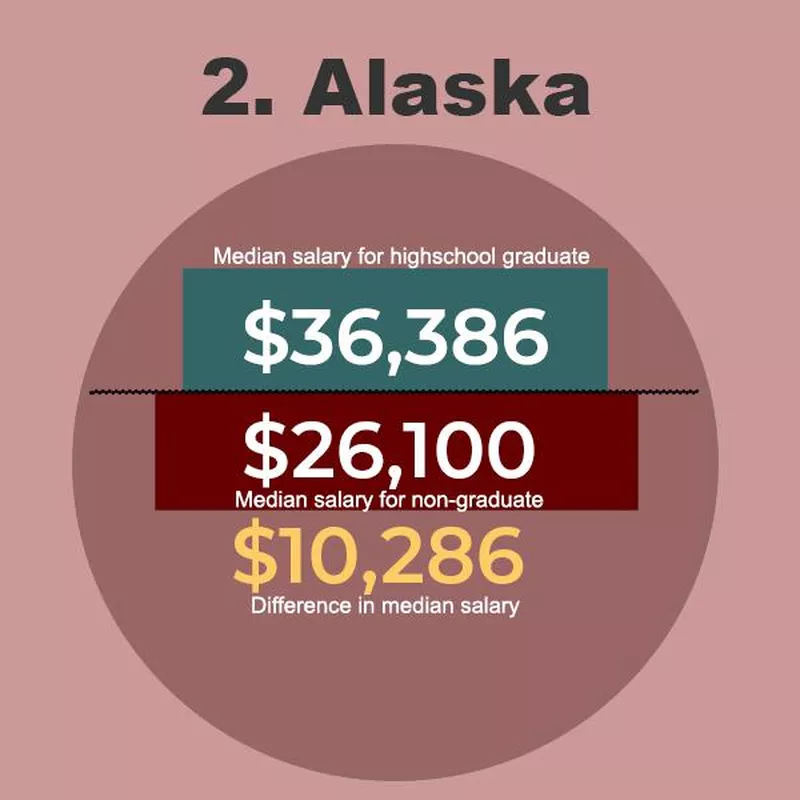
Oil companies drive the economy of the Last Frontier. This isn’t great news for non-graduates, as entry-level jobs still require a diploma. However, only 81 percent of Alaskans obtain one, meaning that 19 percent of the population is left out of the biggest economic activity in the state.
Commercial fishing, hunting and tourism may provide jobs for people that don’t graduate high school. But having a diploma can mean more than $10,000 extra per year. That translates to hundreds of thousands of dollars over a lifetime.
1. Connecticut
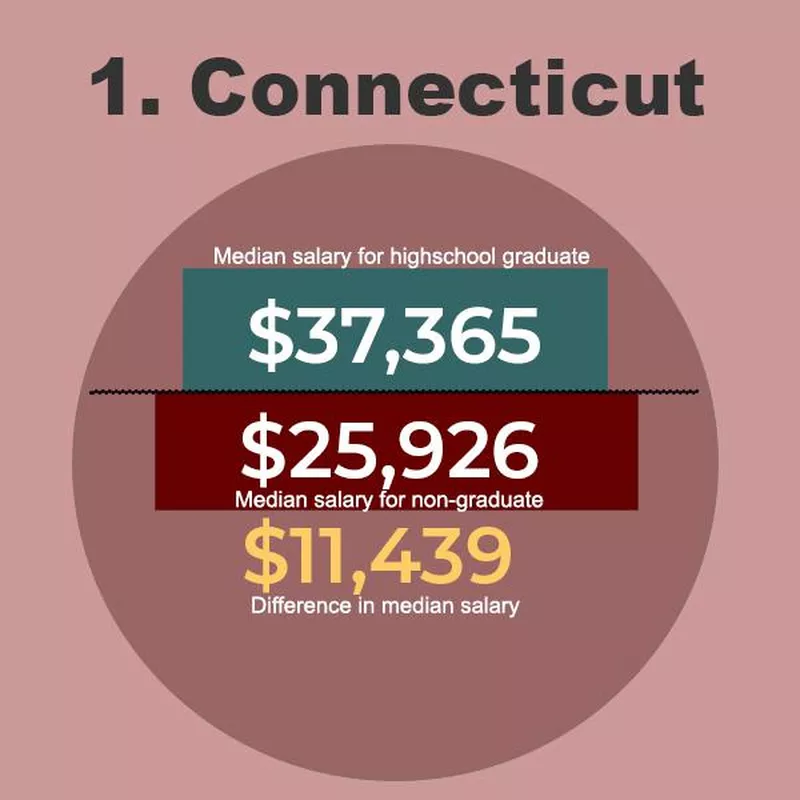
If there is one state that non-graduates should avoid, it’s Connecticut. The difference in median salary for graduates and non-graduates is a shocking $11,439, the worst in the country.
Insurance, aircraft manufacturing, and drug and cosmetics are the leading revenue-generating industries. Higher education also drives the economy, especially in New Haven, where Yale University is located. Luckily, around 93 percent of residents here finish high school.